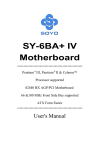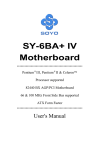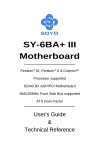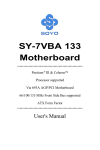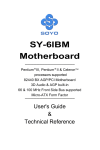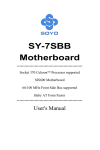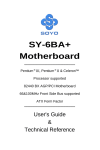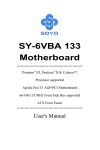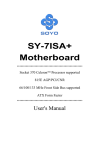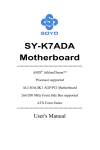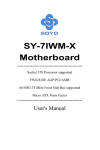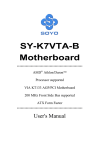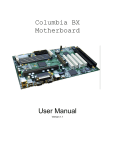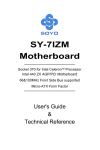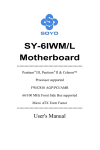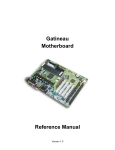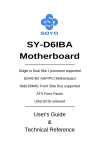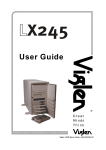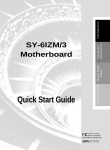Download SY-6BA+100 Motherboard
Transcript
SY-6BA+100 Motherboard **************************************************** Pentium ® III, Pentium® II & Celeron Processor supported 82440 BX AGP/PCI Motherboard 66 & 100 MHz Front Side Bus supported ATX Form Factor **************************************************** User's Manual SOYO ™ SY-6BA+100 Copyright © 1999 bySoyo Computer Inc. Trademarks: Soyo is the registered trademark of Soyo Computer Inc. All trademarks are the properties of their owners. Product Rights: All names of the product and corporate mentioned in this publication are used for identification purposes only. The registered trademarks and copyrights belong to their respective companies. Copyright Notice: All rights reserved. This manual has been copyrighted by Soyo Computer Inc. No part of this manual may be reproduced, transmitted, transcribed, translated into any other language, or stored in a retrieval system, in any form or by any means, such as by electronic, mechanical, magnetic, optical, chemical, manual or otherwise, without permission in writing from Soyo Computer Inc. Disclaimer: Soyo Computer Inc. makes no representations or warranties regarding the contents of this manual. We reserve the right to amend the manual or revise the specifications of the product described in it from time to time without obligation to notify any person of such revision or amend. The information contained in this manual is provided to our customers for general use. Customers should be aware that the personal computer field is subject to many patents. All of our customers should ensure that their use of our products does not infringe upon any patents. It is the policy of Soyo Computer Inc. to respect the valid patent rights of third parties and not to infringe upon or to cause others to infringe upon such rights. Restricted Rights Legend: Use, duplication, or disclosure by the Government is subject to restrictions set forth in subparagraph (c)(1)(ii) of the Rights in Technical Data and Computer Software clause at 252.277-7013. About This Guide: This Quick Start Guide can help system manufacturers and end users in setting up and installing the Motherboard. Information in this guide has been carefully checked for reliability; however, to the correctness of the contents there is no guarantee given. The information in this document is subject to amend without notice. For further information, please visit our Web Site on the Internet. The address is "http://www.soyo.com.tw". Tested To Comply With FCC Standards FOR HOME OR OFFICE USE C FC Edition: April 2000 Version 1.0 6BA+100 SERIAL 100% ii POST CONSUMER RECYCLED PAPER Table of Contents SY-6BA+100 Table of Contents CHAPTER 1 MOTHERBOARD DESCRIPTION...............................1 1-1 INTRODUCTION..............................................................1 1-2 KEY FEATURES...............................................................1 1-3 HANDLING THE MOTHERBOARD ..............................5 1-4 ELECTROSTATIC DISCHARGE PRECAUTIONS.........5 1-5 SY-6BA+100 MOTHERBOARD LAYOUT.....................6 1-6 SY-6BA+100 MOTHERBOARD COMPONENTS ..........7 1-7 MICROPROCESSOR ........................................................9 1-8 MEMORY ..........................................................................9 1-9 CHIPSET .........................................................................11 1-10 I/O INTERFACE CONTROLLER...................................16 1-11 HARDWARE MONITOR................................................18 1-12 WAKE ON LAN TECHNOLOGY ..................................18 CHAPTER 2 HARDWARE INSTALLATION ...................................19 2-1 2-2 2-3 PREPARATIONS .............................................................19 UNPACKING THE MOTHERBOARD ..........................20 INSTALLATION GUIDE ................................................21 2-3.1 CPU Fan Installation .................................................... 22 2-3.2 SDRAM Memory Module Installation ........................... 26 2-3.3 Motherboard Connector................................................ 28 3-3.4 Jumper Setting............................................................... 43 2-3.5 CMOS Clearing (JP5) ................................................... 45 2-3.6 Power On ...................................................................... 46 2-3.7 Quick BIOS Setup.......................................................... 47 2-3.8 Troubleshooting at First Start ....................................... 50 2-3.9 Power Off ...................................................................... 54 CHAPTER 3 BIOS SETUP UTILITY.................................................55 iii Table of Contents 3-1 3-2 3-3 3-4 3-5 3-6 3-7 3-8 3-9 3-10 3-11 SY-6BA+100 SOYO COMBO SETUP ..................................................57 STANDARD CMOS SETUP ...........................................64 BIOS FEATURES SETUP...............................................67 CHIPSET FEATURES SETUP........................................71 POWER MANAGEMENT SETUP .................................74 PNP/PCI CONFIGURATION SETUP.............................78 LOAD SETUP DEFAULTS.............................................81 INTEGRATED PERIPHERALS......................................82 SUPERVISOR PASSWORD ...........................................87 USER PASSWORD .........................................................88 IDE HDD AUTO DETECTION ......................................89 CHAPTER 4 DRIVERS INSTALLATION ..........................................90 CHAPTER 5 THE ATA 66 DRIVER INSTALLATION ....................95 iv Motherboard Description SY-6BA+100 Chapter 1 MOTHERBOARD DESCRIPTION 1-1 INTRODUCTION The SY-6BA+100 AGP/PCI Motherboard is a high-performance Slot 1 supported ATX form-factor system board. SY-6BA+100 uses the Intel ® Chipset technology and supports Slot 1 class processors. This Motherboard is fully compatible with industry standards and adds many technical enhancements. 1-2 KEY FEATURES Ø CPU SUPPORT The SY-6BA+100 supports a wide range of INTEL CPUs: n FSB 100MHz: Intel Pentium ® II 350~450 MHz Intel Pentium ® III 450~800 MHz n FSB 66MHz: Intel Pentium ® II 233~333 MHz Intel Celeron ® 266~433 MHz New released Intel Slot 1 CPUs will very likely be supported by the SY6BA+100 as well. Ø CPU SETTINGS The SY-6BA+100 provides the user with a very complete and convenient CPU setting environment. The CPU settings are all adjusted through the special SOYO COMBO page in the BIOS, therefore rendering the use of jumpers obsolete. n CPU FSB Frequency The SY-6BA+100 supports an incredible wide range of CPU FSB frequency settings: 66, 75, 81, 83, 90, 95, 100, 105, 110, 112, 113, 115, 117, 118, 120, 122, 124, 126, 133, 135, 137, 138, 140, 142, 144, 150 and 155 MHz. This ensures that the SY-6BA+100 has an overwhelming overclocking potential. 1 Motherboard Description SY-6BA+100 n CPU Multiplier The SY-6BA+100 supports a wide range of multipliers: 2.0x, 2.5x, 3.0x, 3.5x, 4.0x, 4.5x, 5.0x, 5.5x, 6.0x, 6.5x, 7.0x, 7.5x and 8.0x n CPU Core Voltage The CPU Core voltage is set automatically according to CPU needs. The SY-6BA+100 supports an advanced Core voltage feature; it can be adjusted through the BIOS directly without setting jumper. In normal mode the voltage will be standard, apart from that the user can specify increments of 2.5%, 5%, 7.5% and 10% on top of the standard voltage. This will provide the CPU with the power it needs for overclocking. Ø EXPANDABILITY The SY-6BA+100 provides all the standard expansion slots, and many more additional expansion features: u Expansion slots n n n u Enhanced IO n n n n n n n n Ø 1 x 32-bit bus mastering AGP slot 5 x 32-bit bus mastering PCI slots 2 x 16-bit ISA slots Floppy disk controller 2x EIDE controllers with support for up to 4 Ultra DMA 33/66 devices Standard/EPP/ECP parallel port 2x 16550 compatible serial ports IrDA compatible infrared port 2x USB (Universal Serial Bus) connectors PS/2 mouse connector PS/2 keyboard connector ADVANCED FUNCTIONS The SY-6BA+100 supports advanced functions such as: n ATA 66 IDE Ports In addition to the original two ATA33 (Ultra DMA/33) IDE ports, the SY-6BA+100 supports two ATA66 (Ultra DMA/66) IDE ports that is 2 Motherboard Description SY-6BA+100 capable of transferring data up to 66 Mbytes/sec (IDE DMA Mode 4). n Wake-On-LAN Supports Wake-On-LAN (Some advanced network cards can wake the system up over the network, the WOL connector is provided by the SY-6BA+100 to support this function). n Multiple boot The SY-6BA+100 supports booting from devices such as CD-ROM. n Power on by modem or alarm If the SY-6BA+100 system is in suspend mode, it can be switched back on through the modem or RTC alarm through this function. This opens a lot of possibilities, such as remote access that switches the system on only after the modem receives a call. Ø FAIL SAFE The SY-6BA+100 comes with added functionality to make managing the system easy and safe u Hardware Monitor The integrated Winbond Hardware Monitor IC and Hardware doctor software enables the user the monitor system voltages, temperatures and FAN speeds. This makes sure that the user is full control of the system u Power Failure Resume Function This function can be set in the BIOS, and determines whether the system will automatically turn on again after a power failure. This function is indispensable for server systems that need to always be on line. u 5VSB Indicator This green LED gives an indication of the presence of the 5V Standby voltage. This voltage is always fed into the motherboard and is used for functions such as WOL. Ø NORTON SOFTWARE PACK n n n Antivirus Ghost Virtual Drive 3 Motherboard Description Ø SY-6BA+100 COMPLIANCE The SY-6BA+100 complies with all important industry standards. The following underlines the reliability of the SY-6BA+100, a motherboard to trust. n Year 2000 compliant n PC98 compliant n FCC/CE complaint Ø USER FRIENDLY n n n SOYO Combo Setup Jumperless design You can set up the following options trough the BIOS setting CPU FSB frequency CPU multiplier CPU Vcore voltage PCI clock AGP Clock SDRAM Clock 4 Motherboard Description 1-3 SY-6BA+100 HANDLING THE MOTHERBOARD To avoid damage to your Motherboard, follow these simple rules while unpacking: Ø Before handling the Motherboard, ground yourself by grasping an unpainted portion of the system's metal chassis. Ø Remove the Motherboard from its anti-static packaging. Hold the Motherboard by the edges and avoid touching its components. Ø Check the Motherboard for damage. If any chip appears loose, press carefully to seat it firmly in its socket. Warning: Do not apply power if the Motherboard appears damaged. If there is damage to the board, contact your dealer immediately. 1-4 ELECTROSTATIC DISCHARGE PRECAUTIONS Make sure to ground yourself before handling the Motherboard or other system components. Electrostatic discharge can easily damage the components. Note that you must take special precautions when handling the Motherboard in dry or air-conditioned environment. To protect your equipment from electrostatic discharge, take the following precautions: Ø Do not remove the anti-static packaging until you are ready to install. Ø Ground yourself before removing any system component from its protective anti-static packaging. (To ground yourself, grasp the expansion slot covers or other unpainted portions of the computer chassis.) Ø Frequently ground yourself while working or use a grounding strap. Ø Handle the Motherboard by its edges and avoid touching its components. 5 Motherboard Description SY-6BA+100 1-5 SY-6BA+100 MOTHERBOARD LAYOUT PS/2 KB Connector PS/2 Mouse Connector JP10 JP8 LED1 3 1 1 PWRFAN USB 1 DIMM 1 USB 2 ® 1 Slot DIMM 2 DIMM 3 DIMM 4 1 CPUFAN PRT FDC COM 1 ATA 33 ATX Power 82443 BX 1 AGP Slot PCI Slot #1 TM Flash BIOS 1 PCI Slot #2 3V Lithium Battery PCI Slot #3 Intel® PCI Slot #4 82371 EB JP1 ISA Slot #1 Keylock PWRBT _ 828AC ISA Slot #2 Hardware Monitoring Power LED + 1 CHAFAN Back Panel SY-6BA+100 Platform 6 3 HDD + LED Tubro + LED + Speaker PCI Slot #5 Winbond W83782M JP5 CMOS Clear Jumper 1 _ 3 5 1 SB-LINK (PC PCI) _ WOL Header IR1 1 _ 1 1 IDE 2 IDE 1IDE 3 IDE4 ITE 8671 I/O Chipset JP44 ATA 66 11 Intel® COM 2 Reset Motherboard Description SY-6BA+100 1-6 SY-6BA+100 MOTHERBOARD COMPONENTS A B C D E F G H I ® AB J 1 ® K L M AA N Z O P ® Q R Y X S W 828AC T VU 7 Motherboard Description A B C D E F G H I J K L M N O P Q R S T U V W X Y Z AA AB SY-6BA+100 ATX Power Supply Connector Slot 1 Connector Power On by Keyboard Jumper CPU multiplier release Jumper Intel 82440 BX PCI/AGP Set CPU Cooling Fan Connector Power Cooling Fan Connector DIMM Bank 5V Stand-by indicator LED Floppy Disk Drive (FDD) Port Bus Mastering E-IDE/ATAPI Ports 32-bit AGP Slot PCI Audio Card Header High Point PHT 370 ATA66 Controller 32-bit PCI Mastering Slots 3V Lithium Battery CMOS Clear Jumper Intel 82371 EB PIIX4 Chip Front panel connectors Chassis Cooling Fan Connector External Suspend Button Header 16-bit ISA Slots Winboand W83782M hardware monitoring Flash BIOS Chip Wake-On-LAN (WOL) Header Serial Infrared (IrDA) Device Header ITE 8671 super I/O Controller Back panel Connectors 8 Motherboard Description SY-6BA+100 1-7 MICROPROCESSOR The motherboard supports a single Slot 1 processor. The processor’s VID pins automatically program the voltage regulator on the motherboard to the required processor voltage. In addition, the front side bus speed (66 MHz and 100 MHz) is automatically selected. The motherboard supports all current Slot 1 processor speeds, voltages, and bus frequencies. 1-7.1 Microprocessor Packaging The processor is packaged in a Single Edge Contact Cartridge (SECC or SECC2) or Single Edge Processor Package (S.E.P.P). The cartridge includes the processor core, second-level cache subsystem, thermal plate, and back cover. The processor connects to the motherboard through the Slot1 connector, a 242-pin edge connector. When mounted in Slot1, the processor is secured by a retention mechanism attached to the motherboard. A passive heatsink is stabilized by the heatsink supports. 1-7.2 Second Level Cache The second-level cache is located on the substrate of the CPU package. The cache includes 0KB/128KB (Celeron) or 512 KB (PII/PIII) of synchronous pipelined burst static RAM. All supported onboard memory can be cached. 1-7.3 Microprocessor Upgrades The motherboard can be upgraded with Slot 1 processors that run at higher speeds. When upgrading the processor, use the BIOS configuration mode to change the processor speed. 1-8 MEMORY 1-8.1 Main Memory The motherboard has four DIMM sockets. SDRAM can be installed in one, 9 Motherboard Description SY-6BA+100 two, three, or four sockets. Using the serial presence detect (SPD) data structure, programmed into an E²PROM on the DIMM, the BIOS can determine the SDRAM’s size and speed. Minimum DIMM memory size is 8 MB; maximum DIMM memory size is 256MB. Memory size and speed can vary between sockets. The motherboard supports the following memory features: l 168-pin DIMMs with gold-plated contacts l 66/100/133 MHz SDRAM l Non-ECC (64-bit) and ECC (72-bit) memory l 3.3V memory only l Supports 8/16/32/64/128/256 MB DIMM Modules l Support unbuffered or registered single- or double-sided DIMMs ¿ Note Slot 1 processors with 100 MHz front-side bus should be paired only with 100 MHz SDRAM. Processors with 66 MHz front side bus can be paired with either 66 MHz or 100 MHz SDRAM. 1-8.2 SDRAM SDRAM improves memory performance through memory access that is synchronous with the front-side bus clock. Burst transfer rates at x-1-1-1 timing can be achieved using SDRAM, while asynchronous memory subsystem are typically limited at x-2-2-2 transfer rates. ¿ Note All memory components and DIMMs used with the SY-6BA+100 motherboard must comply with the PC SDRAM specifications. These include: the PC SDRAM Specification (memory component specific), the PC Unbuffered DIMM Specification, and the PC Serial Presence Detect Specification. 10 Motherboard Description SY-6BA+100 1-8.3 ECC Memory ECC memory detects multiple-bit errors and corrects single-bit errors. When ECC memory is installed, the BIOS supports both ECC and nonECC mode. ECC mode is enabled in the Setup program. The BIOS automatically detects if ECC memory is installed and provides the Setup option for selecting ECC mode. If any non-ECC memory is installed, the Setup option for ECC configuration does not appear and ECC operation is not available. 1-9 CHIPSET The Intel 440BX PCIset includes a Host-PCI bridge integrated with both an optimized DRM controller and an A.G.P. interface. The I/O subsystem of the 440BX is based on the PIIX4E, which is a highly integrated PCIISA/IDE Accelerator Bridge. This chipset consists of the Intel 82443BX PCI/A.G.P. controller (PAC) and the Intel 82371EB PCI/ISA IDE Xcelerator (PIIX4E) bridge chip. 1-9.1 Intel 82443Bx PCI/A.G.P. Controller (PAC) The PAC provides bus-control signals, address paths, and data paths for transfers between the processor’s host bus, PCI bus, the A.G.P., and main memory. The PAC features: l Processor interface control Ø Support for processor host bus frequencies of 100 MHz or 66MHz Ø 32-bit addressing Ø Desktop Optimized GTL+ compliant host bus interface l Integrated DRAM controller, with support for: Ø +3.3 V only DIMM DRAM configurations Ø Up to four double sided DIMMs Ø 100-MHz or 66MHz SDRAM Ø DIMM serial presence detect via SMBus interface Ø 16-and 64-Mbit devices with 2K, 4K, and 8K page sizes Ø SDRAM 64-bit data interface with ECC support Ø Symmetrical and asymmetrical DRAM addressing 11 Motherboard Description l SY-6BA+100 A.G.P. interface Ø Complies with the A.G.P. specification Ø Support for +3.3 V A.G.P.-66/ devices Ø Synchronous coupling to the host-bus frequency l PCI bus interface Ø Complies with the PCI specification Ø Asynchronous coupling to the host-bus frequency Ø PCI parity generation support Ø Data streaming supports from PCI-to-DRAM Ø Support for five PCI bus masters in addition to the host and PCIto-ISA I/O bridge Ø Support for concurrent host, A.G.P., and PCI transactions to main memory l Data buffering Ø DRAM write buffer with read-around-write capability Ø Dedicated host-to-DRAM, PCI-to-DRAM, and PCI-A.G.P.-toDRAM read buffers Ø A.G.P. dedicated inbound/outbound FIFOs (133/66 MHz), used for temporary data storage l Power management functions Ø Support for system suspend/resume (DRAM and power-on suspend) Ø Compliant with ACPI power management l SMBus support for desktop management functions l Support for system management mode (SMM) 1-9.2 Intel 82371EB PCI ISA IDE Xcelerator (PIIX4E) The PIIX4E is a multifunction PCI device implementing the PCI-to-ISA bridge, PCI IDE functionality, USB host/hub functionality, and enhanced power management. The PIIX4E features: l Multifunction PCI-to-ISA bridge Ø Support for the PCI bus at 33 MHz 12 Motherboard Description SY-6BA+100 Ø Complies with the PCI specification Ø Full ISA bus support l USB controller Ø Two USB ports Ø Support for legacy keyboard and mouse Ø Support for UHCI interface l Integrated dual-channel enhanced IDE interface Ø Support for up to four IDE devices Ø PIO mode 4 transfers at up to 16 MB/sec Ø Support for Ultra DMA/33 synchronous DMA mode transfers up to 33 MB/sec Ø Bus master mode with an 8 x 32-bit buffer for bus master PCI IDE burst transfers l Enhanced DMA controller Ø Two 8237-based JDMA controllers Ø Supports for PCI DMA with three PC/PCI channels and distributed DMA protocols l Interrupt controller based on 82C59 Ø Support for 15 interrupts Ø Programmable for edge/level sensitivity l Power management logic Ø Sleep/resume logic Ø Support for wake-on-modem, Wake on LAN technology, and w3ake on PME Ø l l Support for ACPI Real-Time Clock Ø 256-byte battery-backed CMOS SRAM Ø Includes date alarm 16-bit counters/timers based on 82C54 1-9.3 Accelerated Graphics Port (A.G.P.) A.G.P. is a high-performance bus for graphics-intensive applications, such as 3D applications. A.G.P., while based on the PCI Local Bus 13 Motherboard Description SY-6BA+100 Specifications, Rev 2.1, is independent of the PCI bus and is intended for exclusive use with graphical display devices. A.G.P. overcomes certain limitations of the PCI bus related to handling a large amount of graphics data with the following features: l Pipelined memory read and write operations that hide memory access latency l Demultiplexing of address and data on the bus for near 100 percent bus efficiency l AC timing for 133 MHz data transfer rates, allowing real data throughput in excess of 500 MB/sec 1-9.4 Universal Serial Bus (USB) The motherboard has two USB ports; one USB peripheral can be connected to each port. For more than two USB devices, an external hub can be connected to either port. The motherboard fully supports the universal host controller interface (UHCI) and used UHCI-compatible software drivers. Specification USB features include: l Self-identifying peripherals that can be plugged in while the computer is running l Automatic mapping of function to driver and configuration l Support for isochronous and asynchronous transfer types over the same set of wires l Support for up to 127 physical devices l Guaranteed bandwidth and low latencies appropriate for telephony, audio, and other applications l Error-handling and fault-recovery mechanisms built into the protocol ¿ Note Computer systems that have an unshielded cable attached to a USB port may not meet FCC Class B requirements, even if no device or a low-speed USB device is attached to the cable. Use shielded cable that meets the requirements for a full-speed USB device. 14 Motherboard Description SY-6BA+100 1-9.5 IDE Support The motherboard has two independent ATA 33 and two independent ATA 66 bus-mastering PCI IDE interfaces. These interfaces support PIO Mode3, PIO Mode 4, ATAPI devices (e.g., CD-ROM), and Ultra DMA/33 (IDE1, IDE2) or Ultra DMA/66 (IDE3, IDE4) synchronous-DMA mode transfers. See “IDE Device installation” (on page 29) for more information. The BIOS supports logical block addressing (LBA) and extended cylinder head sector (ECHS) translation modes. The BIOS automatically detects the IDE device transfer rate and translation mode. Programmed I/O operations usually require a substantial amount of processor bandwidth. However, in multitasking operating systems, the bandwidth freed by bus mastering IDE can be devoted to other tasks while disk transfers are occurring. The motherboard also supports laser servo (LS-120) drives. LS-120 technology allows the user to perform read/write operations to LS-120 (120MB) and conventional 1.44MB and 720KB diskettes. An optical servo system is used to precisely position a dual-gap head to access the diskett’s 2,490 tracks per inch (tpi) containing up to 120 MB of data storage. A conventional diskette uses 135 tpi for 1.44 MB of data storage. LS-120 drivers are ATAPI-compatible and connect to the motherboard’s IDE interface. (LS-120 drives are also available with SCJSI and parallel port interfaces.) Some versions of Windows 95 and Windows NT operating systems recognize the LS-120 drive as a bootable device in both 120 MB and 1.44 MB mode. Connection of an LS-120 drive and a standard 3.5-inch diskette drive is allowed. The LS-120 drive can be configured as a boot device if selected as Drive A in the BIOS setup program. ¿ Note If you connect at LS-120 drive to an IDE connector and configure it as the :boot: drive and configure a standard 3.5-inch diskette drive as a “B” drive, the standard diskette drive is not seen by the operating system. When the LS-120 drive is configured as the “boot: device, the system will 15 Motherboard Description SY-6BA+100 recognize it as both the A and B drive 1-9.6 Real-Time Clock, CMOS SRAM, and Battery The real-time clock is compatible with DS1287 and MC146818 components. The clock provides a time-of-day clock and a multicentury calendar with alarm features and century rollover. The real-time clock supports 256 bytes of battery-backed CMOS SRAM in two banks that are reserved for BIOS use. The time, date, and CMOS values can be specified in the Setup program. The CMOS values can be returned to their defaults by using the Setup program. 1-10 I/O INTERFACE CONTROLLER The motherboard uses the ITE 8671 super I/O controller which features: l Single diskette drive interface l ISA Plug-and-Play compatible register set l Two serial ports l FIFO supports on both serial and diskette interfaces l One parallel port with Extended Capabilities Port (ECP) and Enhanced Parallel Port (EPP) support l PS/2 style mouse and keyboard interfaces l PCI PME interface l Vialigent auto power management, including: Ø Shadowed write-only registers for ACPI compliance Ø Programmable wake-up event interface The Setup program provides configuration option for the I/O controller. 1-10.1 Serial Ports The NS16C5450-compatible UARTs support data transfers at speeds up to 115.2 Kbits/sec with BIOS support. 1-10.2 Parallel Port In the Setup program, there are four options for parallel port operation: l Compatible (standard mode) 16 Motherboard Description SY-6BA+100 l Bi-directional (PS/2 compatible) l Bi-directional EPP. A driver from the peripheral manufacturer is required for operation. l Bi-directional high-speed ECP 1-10.3 Diskette Drive Controller The I/O controller is software compatible with the 82077 diskette drive controller and supports both PC-AT and PS/2 modes. In the Setup program, the diskette drive interface can be configured for the following diskette drive capacities and sizes. l 360 KB, 5.25-inch l 1.2 MB, 5.25-inch l 720 KB, 3.5-inch l 1.2 MB. 3.5-inch (driver required) l 1.25-1.44 MB, 3.5-inch l 2.88 MB, 3.5-inch 1-10.4 Keyboard and Mouse Interface The +5 V lines to keyboard and mouse connectors are protected with a fuse that prevents motherboard components from being damaged when an over-current condition occurs. The keyboard controller contains code, which provides the traditional keyboard and mouse control functions, and also supports Power On/Reset password protection. Power On/Reset password can be specified in the BIOS Setup program. The keyboard controller also supports the hot-key sequence <Ctrl><Alt><Del>, software reset. This key sequence resets the computer’s software by jumping to the beginning of the BIOS code and running the Power On Self Test (POST). 1-10.5 Infrared Support The IR connection can be used to transfer files to or from portable devices like laptops, PDAs, and printers. 17 Motherboard Description SY-6BA+100 1-11 HARDWARE MONITOR The optional hardware monitor subsystem provides low-cost instrumentation capabilities. The features of the hardware monitor subsystem include: Ø An integrated ambient temperature sensor Ø Fan speed sensors, which monitor the fan 1 and fan 2 connectors Ø Power supply voltage monitoring to detect levels above or below acceptable values When suggested ratings for temperature, fan speed, or voltage are exceeded, an interrupt is activated. The hardware monitor component connects to the SMBus. 1-12 WAKE ON LAN TECHNOLOGY Wake on LAN technology enables remote wakeup of the computer through a network. Wake on LAN technology requires a PCI add-in network interface card (NIC) with remote wakeup capabilities. The remote wakeup connector on the NIC must be connected to the onboard Wake on LAN technology connector. The NIC monitors network traffic at the MII interface; upon detecting a Magic Packet, the NIC asserts a wakeup signal that powers up the computer. To access this feature uses the Wake on LAN technology connector. * CAUTION For Wake on LAN, the 5-V standby line for the power supply must be capable of delivering +5V ±5 % at 720 mA. Failure to provide adequate standby current when implementing Wake on LAN can damage the power supply. 18 Hardware Installation SY-6BA+100 Chapter 2 HARDWARE INSTALLATION Congratulations on your purchase of SY-6BA+100 Motherboard. You are about to install and connect your new Motherboard. Note: Do not unpack the Motherboard from its protective antistatic packaging until you have made the following preparations. 2-1 PREPARATIONS Gather and prepare all the following hardware equipment to complete the installation successfully: 1. Slot 1 processor with built-in CPU cooling fan (boxed type). Note: This Motherboard supports non-boxed type CPUs. The heavier CPU cooling fan requires the installation of a CPU support stand. 2. DIMM memory module(s) 3. Computer case and chassis with adequate power supply unit 4. Monitor 5. PS/2 Keyboard 6. Pointing Device (PS/2 mouse) 7. Speaker(s) (optional) 8. Disk Drives: HDD, CD-ROM, Floppy drive … 9. External Peripherals: Printer, Plotter, and Modem (optional) 10. Internal Peripherals: Modem and LAN cards (optional) 19 Hardware Installation 2-2 SY-6BA+100 UNPACKING THE MOTHERBOARD When unpacking the Motherboard, check for the following items: u The SY-6BA+100 82440 BX AGP/PCI Motherboard u The Quick Start Guide u The Installation CD-ROM u SOYO 3-in-1 Bonus Pack CD-ROM (Norton AntIVirus, Ghost and Virtual Drive) u The CPU Retention Set u One IDE Device ATA 66 Flat Cable u One IDE Device Flat Cable u One Floppy Disk Drive Flat Cable Warning: Do not unpack the Motherboard from its anti-static packaging until you are ready to install it. Like most electronic equipment, your Motherboard may be damaged by electrostatic discharge. To avoid permanent damage to components ground yourself while working by using a grounding strap. Otherwise, ground yourself frequently by touching the unpainted portion of the computer chassis to drain the static charges. Handle the Motherboard carefully, holding it by the edges. You are now ready to start the installation. 20 Hardware Installation SY-6BA+100 2-3 INSTALLATION GUIDE We will now begin the installation of the Motherboard. Please follow the step-by-step procedure designed to lead you to a complete and correct installation. Warning: Turn off the power to the Motherboard, system chassis, and peripheral devices before performing any work on the Motherboard or system. BEGIN THE INSTALLATION 21 Hardware Installation SY-6BA+100 2-3.1 CPU Installation Your SY-6BA+100 motherboard comes with a CPU retention set kit. The retention set is used to hold the processor attached to the Slot 1 CPU connector on the motherboard. Mark your CPU Frequency: Record the working frequency of your CPU that should be clearly marked on the CPU cover. FSB 66MHz 266MHz (66 x 4.0) 300MHz (66 x 4.5) 333MHz (66 x 5.0) 366MHz (66 x 5.5) 400MHz (66 x 6.0) 433MHz (66 x 6.5) 466MHz (66 x 7.0) 500MHz (100 x 5.0) 550MHz (100 x 5.5) 600MHz (100 x 6.0) 650MHz (100 x 6.5) 700MHz (100 x 7.0) 750MHz (100 x 7.5) 800MHz (100 x 8.0) FSB 100MHz 350MHz (100 x 3.5) 400MHz (100 x 4.0) 450MHz (100 x 4.5) Follow these instructions to install your Slot 1 processor correctly. Ø Retention Module 22 Hardware Installation SY-6BA+100 1. Open the two sides by folding them up. 2. Push the locks on top of the CPU inward. 23 Hardware Installation 3. SY-6BA+100 Insert the CPU into the retention module. The CPU fits in the CPU slot in only ONE way, do not try to force it in. 4. After completely inserting the CPU, push the two locks on top of the CPU outward. Now your CPU is ready for use. To remove the CPU, press the two notches on top of the CPU inward. Now press the two slides on the retention module down and remove the CPU. 24 Hardware Installation SY-6BA+100 Note: Installing a heat sink and cooling fan on top of your CPU is necessary for proper heat dissipation. Failing to install these items may result in overheating and possible burn-out of your CPU. 2-3.1.1 CPU Fan Installation Your Slot 1 processor kit comes with a cooling fan. Mount the fan on the processor according to the instructions provided by the manufacturer. The fan is a key component that will ensure system stability. The fan prevents overheating, therefore prolonging the life of your CPU. Note: Remember to connect the fan to the appropriate power source. 25 Hardware Installation SY-6BA+100 2-3.2 SDRAM Memory Module Installation ® 1 ® ® DIMM 3 DIMM 4 828AC DIMM 1 DIMM 2 Your board comes with four DIMM sockets, providing support for up to 512 Mbytes or 1GB (with registered DIMMs). For 66MHz front side bus CPUs use 12ns or faster memory; for 100MHz front side bus CPUs use 8ns (100MHz, PC100 compliant) memory. 84 1 1 84 26 Hardware Installation SY-6BA+100 Number of Memory Modules DIMM 1 1 1st 2 1st 2nd 3 1st 2nd 3rd 4 1st 2nd 3rd RAM Type Memory Module Size (MB) DIMM 2 DIMM 3 DIMM 4 4th SDRAM 8/16/32/64/128/256 Mbytes Note: (1) 256 MB memory modules available on PC registered DIMM only. (2) Always install memory modules in the order prescribed in this table. (3) Do not install unbuffered and registered memory modules together. Important: It is of prime importance that you install DIMM modules as outlined in the table above in order to preserve signal integrity on 100MHz front side bus systems. 27 Hardware Installation SY-6BA+100 2-3.3 Motherboard Connector 2-3.3.1 IDE Device Installation (HDD, CD-ROM) The 6BA+100 comes with four IDE connectors, with support for up to 8 IDE Devices. For the supported interface modes, refer to the table below: IDE PIO mode Connector DMA Mode ULTRA DMA33 (ATA 33) ULTRA DMA66 (ATA 66) IDE 1 & 2 Yes Yes Yes No IDE 3 & 4 Yes Yes Yes Yes Note: It is required to connect the ATA66 HDDs with the ATA66 flat cable to the motherboard to maintain proper functionality and stability of the ATA66 high speed interface. ATA 33 ® ATA 66 1 ® ® 1 1 IDE 2 IDE 1 1 IDE 3 1 IDE4 828AC Connect one side of the ATA 33 or ATA 66 flat cable to the IDE device (HDD or CD-ROM) and plug the other end to the IDE1~IDE4 directionally keyed IDE connector on the Motherboard. ATA66 cable can be used backward compatible with ATA33 HDD. 28 Hardware Installation SY-6BA+100 80-Conductor ATA 66 Flat Cable 1 40-pin 39 1 39 29 Hardware Installation SY-6BA+100 2-3.3.2 Floppy Drive Installation ® 1 ® Pin -1 FDC Floppy Drive Connector ® 82 8 AC The system supports 5 possible floppy drive types: 720 KB, 1.2 MB, 1.44 MB and 2.88 MB. In addition, this Motherboard supports a 3-mode (720KB/1.2MB/1.44MB) floppy commonly used in Japan. Connect one side of the 34-pin flat cable to the floppy drive and plug the other end to the floppy drive connector on the Motherboard. This Motherboard can support up to 2 floppy drives. 1 33 1 33 30 Hardware Installation SY-6BA+100 2-3.3.3 Front Panel Connections _ _ + HDD LED + ® _ Turbo LED 1 ® + Speaker Key Lock 1 PWRBT _ Power LED + ® 1 Reset 828AC Plug the computer case's front panel devices to the corresponding headers on the Motherboard. 1. Power LED & KeyLock Plug the Power LED cable into the 5-pin Keylock header. Some systems may feature a KeyLock function with a front panel switch for enabling or disabling the keyboard. Connect the KeyLock switch to the 5-pin Keylock header on the Motherboard. Please install according to the following pin assignment: pin 1,3 are for Power LED and pin 4,5 are for Keylock. Key Lock Pin Assignment Power LED Pin Assignment _ + +5V NC 1 GND Control Pin 31 GND Hardware Installation SY-6BA+100 2. Reset Plug the Reset push-button cable into the 2-pin Reset header on the Motherboard. Pushing the Reset button on the front panel will cause the system to restart the boot-up sequence. Reset Pin Assignment 1 Power Good 3. GND Speaker Attach the 4-pin PC speaker cable from the case to the Speaker header on the Motherboard. Speaker Pin Assignment _ + +5V 4. Speaker out NC NC Turbo LED Connecting the 2-pin Turbo LED cable to the corresponding Turbo LED header will cause the LED to light whenever the system is in Turbo mode. The manufacturer has permanently set this Motherboard in Turbo mode due to most hardware and software compliance to turbo mode. Turbo LED Pin Assignment + _ LED Cathode GND 32 Hardware Installation SY-6BA+100 5. IDE LED Attach the 2-pin IDE device LED cable to the corresponding IDE LED header on the Motherboard. This will cause the LED to lighten when an IDE (HDD, CD-ROM) device is active. HDD LED Pin Assignment _ + LED Anode LED Cathode 6. ATX Power On/Off Switch Attach the 2-pin momentary type switch to the PWRBT header for turning On or Off your ATX power supply. PWRBT Pin Assignment 1 Power On/Off 33 GND Hardware Installation SY-6BA+100 2-3.3.4 Back Panel Connections All external devices such as the PS/2 keyboard, PS/2 mouse, printer, modem, USB can be plugged directly onto the Motherboard back panel. Only after you have fixed and locked the Motherboard to the computer case can you start connecting the external peripheral devices. When connecting an external device, use the following figure to locate and identify which back panel connector to plug the device to. PS/2 KB PS/2 Mouse Connector Connector ® USB 1 1 ® USB 2 PRT COM 1 ® COM 2 828AC 34 Hardware Installation SY-6BA+100 1. Onboard Serial Ports COM1/COM2 External peripherals that use serial transmission scheme include: - serial mouse, - and modem. Plug the serial device cables directly into the COM1/COM2 9-pin male connectors located at the rear panel of the Motherboard. 2. Parallel Port PRT This parallel port is used to connect the printer or other parallel devices. Plug the parallel device cable into the 25-pin female connector located at the rear panel of the Motherboard. 3. PS/2 Keyboard Plug the keyboard jack directly into the 6-pin female PS/2 keyboard connector located at the rear panel of the Motherboard. Pin6 NC Pin4 VCC Pin2 NC 4. Pin5 KBD Clock Pin3 GND Pin1 KBD DATA PS/2 Mouse Similarly, plug the mouse jack directly into the 6-pin female PS/2 mouse connector. Pin6 NC Pin5 Mouse Clock Pin4 VCC Pin2 NC Pin3 GND Pin1 Mouse DATA 35 Hardware Installation SY-6BA+100 5. Universal Serial Bus USB1/USB2 This Motherboard provides two USB ports for your additional devices. Plug the USB device jack into the available USB connector USB1 or USB2. - Standard device drivers come with the Win98 for commonly used USB devices. - With Win95, use the flow UHCI specifications. To use USB devices under Win95, usually you have to install the device driver comes with the USB device you have purchased. 36 Hardware Installation SY-6BA+100 2-3.3.5 Other Connections 1. Wake-On-LAN (WOL) Attach the 3-pin connector from the LAN card which supports the WakeOn-LAN (WOL) function to the JP44 header on the Motherboard. This WOL function lets users wake up the connected computer through the LAN card. Please install according to the following pin assignment: Wake-On-LAN JP44 Pin Assignment MP-Wake-up 3 GND 2 5VSB 1 37 Hardware Installation SY-6BA+100 2. Infrared (IR1) Plug the 5-pin infrared device cable to the IR1 header. This will enable the infrared transfer function. This Motherboard meets both the ASKIR and HPSIR specifications. Please install according to the following pin assignment: Serial Infrared (IR1) Connector IR1 Pin Assignment 1 2 3 4 5 VCC IRRX GND IRTX 3. Other Display Cards Insert other types of VGA cards into the PCI or ISA expansion slots according to card specifications. 38 Hardware Installation 4. SY-6BA+100 Cooling Fan Installation (1) CPU Cooling Fan After you have seated the CPU properly on the processor, attach the 3-pin fan cable to the CPUFAN connector on the Motherboard. The fan will stop when the system enters into Suspend Mode. (Suspend mode can be enabled from the BIOS Setup Utility, [POWER MANAGEMENT] menu.) To avoid damage to the system, install according to the following pin assignment: CPU Cooling Fan CPUFAN Pin Assignment SENSOR 3 12V 2 GND 1 39 Hardware Installation SY-6BA+100 (2) Chassis Cooling Fan Some chassis also feature a cooling fan. This Motherboard features a CHAFAN connector to provide 12V power to the chassis fan. Connect the cable from the chassis fan to the CHAFAN 3-pin connector. Install according to the following pin assignment: Chassis Cooling Fan CHAFAN Pin Assignment 1 GND 3 2 12V SENSOR Note: CPUFAN must be installed for this Motherboard, CHAFAN is optional. 40 Hardware Installation SY-6BA+100 2-3.3.6 AGP VGA Card Insert the AGP VGA card into the AGP slot. Then connect the monitor information cable to the AGP card back plane external connector. Follow the manufacturer's instructions to perform the AGP VGA drivers installation. Other Display Cards: Insert other types of VGA cards into the PCI or ISA expansion slots according to card specifications. 2-3.3.7 PCI Audio Card Some PCI soundcards require a PC-PCI DMA channel. Attach the 5-pin cable from your PCI audio card to the SB-LINK ™header on the Motherboard. The SB-LINK™ will forward requests for legacy DMA channel to the PCI Bus. TM SB-LINK (PC/PCI) Pin Assignment 1 6 PC/PCI Grant Sideband Signal Serial IRQ 2 DGND 4 5 DGND PC/PCI Request Sideband Signal 41 Hardware Installation SY-6BA+100 2-3.3.8 ATX Power Supply Plug the connector from the power directly into the 20-pin male ATX PW connector on the Motherboard, as shown in the following figure. ATX Power ® 1 ® ® 828AC Warning: Follow these precautions to preserve your Motherboard from any remnant currents when connecting to power supply: Turn off the power supply and unplug the power cord of the power supply before connecting to PW connector. 42 Hardware Installation SY-6BA+100 This motherboard requires a power supply, that meets the ATX 2.03 specifications. Make sure the power supply can support at least 720mA on the 5V Standby lead. Please install the ATX power according to the following pin assignment: ATX Power 12V 5VSB PW-OK GND 5V GND 5V GND 3.3V 3.3V 5V 5V -5V GND GND Ø Pay special care to the directionality. GND PS-ON GND -12V 3.3V 2-3.4 Jumper Setting Step 1. 5V Stand-by indicator LED (LED 1) This LED is lit whenever the 5V Standby voltage coming from the ATX power supply is available. If you have connected your ATX power supply to the motherboard, LED 1 should be lit. Step 2. External Suspend Button (JP1) Some cases come with a suspend button, insert the plug into JP1. In addition to this button, the system can also enter the suspend mode through your OS. Note: Suspend mode only functions if your Power Management mode is APM. Make sure that the BIOS setting for Power Management is APM. Windows 98 can be installed with ACPI Power Management (default is APM), in this case suspend mode will not function either. 43 Hardware Installation SY-6BA+100 Step 3. CPU multiplier release Jumper: (JP8) Closing JP8 can make higher multiplier settings available on some INTEL CPUs. For technical details read the following: Your Pentium CPU has an input pin B21 (100/66# signal) to tell it at what Front Side Bus (FSB) Frequency it is running; JP8 is connected to this input pin. The actual FSB Frequency is however set through the BIOS and it may therefore differ from the Frequency specified to the CPU through JP8. Because some INTEL CPUs have their multipliers limited at a FSB Frequency of 100MHz and higher, telling the CPU that it is running at 66MHz though JP8 while setting a different (higher) FSB Frequency in the BIOS may allow the user to set a higher multiplier value. Doing so will however force your CPU to operate out of its specifications, and therefore SOYO can not guarantee the proper functioning of your system. Refer to the following table: Mode JP8 66MHz FSB clock CPUs Setting 66MHz FSB clock CPUs must use this setting short 1 2 100MHz FSB clock CPUs Setting Normal open 1 2 Possible higher multiplier limit short 1 2 Note: Shorting the jumper will tell the CPU that it is running on 66MHz, this will release more multiplier settings on some INTEL CPUs, but will make the system operate out of its specifications if the actual frequency is 100 MHz or higher. 44 Hardware Installation SY-6BA+100 Step 4. Power-On by Keyboard Jumper (JP10) You can choose to enable the Power-On by Keyboard function by shorting pin 1-2 on jumper JP10, otherwise, short pin 2-3 to disable this function. Power-On by Keyboard JP10 Setting Enable Disable Short pin 2-3 and the Power-On by Keyboard function is disabled. Short pin 1-2 to enable the PowerOn by Keyboard function. 1 2 3 1 2 3 Note: When using the Power-On by Keyboard function, please make sure the ATX power supply can take at least 720mA load on the 5V Standby lead (5VSB) to meet the standard ATX specification. 2-3.5 CMOS Clearing (JP5) In some cases the CMOS memory may contain wrong data, follow the steps below to clear CMOS memory. 1. Clear the CMOS memory by momentarily shorting pin 2-3 on jumper JP5. This jumper can be easily identified by its white colored cap. 2. Then put the jumper back to 1-2 to allow writing new of data into the CMOS memory. CMOS Clearing Clear CMOS Data Short pin 2-3 for JP5 Setting at least 5 seconds to clear the CMOS Retain CMOS Data Short pin 1-2 to retain new settings 1 2 3 1 2 3 Note: You must unplug the ATX power cable from the ATX power connector when performing the CMOS Clear operation. 45 Hardware Installation SY-6BA+100 2-3.6 Power On You have now completed the hardware installation of your Motherboard successfully. 1. Turn the power on 2. To enter the BIOS Setup Utility, press the <DEL> key while the system is performing the diagnostic checks, Note: If you have failed to enter the BIOS, wait until the boot up sequence is completed. Then push the RESET button and press <DEL> key again at the beginning of boot-up, during diagnostic checks. Repeat this operation until you get the following screen. 3. The BIOS Setup screen appears: ROM PCI/ISA BIOS CMOS SETUP UTILITY AWARD SOFTWARE, INC. SOYO COMBO SETUP INTEGRATED PERIPHERALS STANDARD CMOS SETUP SUPERVISOR PASSWORD BIOS FEATURES SETUP USER PASSWORD CHIPSET FEATURES SETUP IDE HDD AUTO DETECTION POWER MANAGEMENT SETUP SAVE & EXIT SETUP PNP/PCI CONFIGURATION EXIT WITHOUT SAVING LOAD SETUP DEFAULTS ↑ ↓ → ← : Select Item Esc : Quit F10 : Save & Exit Setup (Shift) F2 : Change Color Time, Date, Hard Disk Type… 46 Hardware Installation SY-6BA+100 2-3.7 Quick BIOS Setup This Motherboard does not use any hardware jumpers to set the CPU frequency. Instead, CPU settings are software configurable with the BIOS [SOYO COMBO SETUP]. The [SOYO COMBO SETUP] menu combines the main parameters that you need to configure, all in one menu, for a quick setup in BIOS. After the hardware installation is complete, turn the power switch on, then press the <DEL> key during the system diagnostic checks to enter the Award BIOS Setup program. The CMOS SETUP UTILITY will display on screen. Follow these steps to configure the CPU settings. SETUP UTILITY will display on screen. Then, follow these steps to configure the CPU settings. Step 1. Select [STANDARD CMOS SETUP] Set [Date/Time] and [Floppy drive type], then set [Hard Disk Type] to “Auto”. Step 2. Select [LOAD SETUP DEFAULT] Select the “LOAD SETUP DEFAULT” menu and type “Y” at the prompt to load the BIOS optimal setup. Step 3. Select [SOYO COMBO SETUP] Move the cursor to the [CPU Frequency] field to set the CPU frequency. (1) CPU Name & CPU ID The BIOS will read the CPU name string and CPU ID code From the CPU and it will display it here. This item provides information only and can not be change. 47 Hardware Installation SY-6BA+100 (2) CPU Frequency Available [CPU Frequency] settings on your SY-6BA+100 Motherboard are detailed in the following table. CPU Frequency (MHz) Manual 350MHz (100 x 3.5) 233MHz (66 x 3.5) 400MHz (100 x 4 266MHz (66 x 4 ) 450MHz (100 x 4.5) ) 300MHz (66 x 4.5) 500MHz (100 x 5 333MHz (66 x 5 ) 550MHz (100 x 5.5) ) 366MHz (66 x 5.5) 600MHz (100 x 6 400MHz (66 x 6 ) 650MHz (100 x 6.5) ) 433MHz (66 x 6.5) 700MHz (100 x 7 466MHz (66 x 7 ) 750MHz (100 x 7.5) 500MHz (66 x 7.5) 800MHz (100 x 8.0) Select the working frequency of your Pentium ® III, Pentium ® II, Celeron processor among these preset values. Note: Mark the checkbox that corresponds to the working frequency of your Pentium ® III Pentium ® III, Celeron processor in case the CMOS configuration should be lost. ) If you set this field to [Manual], you are required to fill in the next two consecutive fields: (a) the CPU Host/PCI Clock, and (b) the CPU Ratio. (a) CPU Host/PCI Clock CPU Host / PCI Clock o66/33 o95/31 o75/37 o100/33 o78/39 o105/35 o81/40 o110/36 o83/40 o112/37 o90/30 o113/37 Under this item you find the o115/38 o124/41 o140/35 frequencies your PCI and AGP slots run at. These frequencies o117/39 o126/31 o142/35 are derived from the CPU host o118/39 o133/33 o144/36 clock in the following way: CPU host clock > 100MHz o120/40 o135/33 o150/37 PCI = CPU host clock /3, o122/37 o137/34 o155/38 CPU host clock < 100MHz PCI = CPU host clock /2, o124/31 o138/34 (b) CPU Ratio After you have selected the CPU Host/ PCI Clock, choose the right multiplier for the CPU. CPU Ratio options are: ox2 o x 4.5 ox7 o x 2.5 ox5 o x 7.5 ox3 o x 5.5 ox8 o x 3.5 ox6 ox4 o x 6.5 The CPU frequency is then defined as [host clock freq.] x [multiplier], and 48 Hardware Installation SY-6BA+100 should the working frequency of your CPUs processor. (c) AGP Clock This option allows you to manually adjust the AGP host bus clock frequency to a value determined as a fraction of the CPU host clock. For example: With a CPU front side bus of 100MHz, [Auto] sets à When [auto] is selected and the (FSB Frequency) is less then 100MHz, it will be divided by [/ 1]. Otherwise it will be divided by [/ 1.5]. [/ 1] sets à AGP Clock = 100MHz [/ 1.5] sets à AGP Clock = 66.6MHz AGP Clock options are: o Auto o ÷1.0 o÷1.5 (d) Vcore Voltage Adjust The CPU notifies the board of what core voltage it requires by its VID outputs. The on-board voltage regulator uses the VID code to set the core voltage. If the Vcore Voltage Adjust is set to normal, the Vcore will be exactly what the VID code specifies. If an adjustment percentage is selected the Vcore will be that percentage higher than the VID code specifies. For instance the CPU VID code specifies 2.0V and the Vcore Voltage adjust is set to +10.0% the actual CPU Voltage will be 2.2V. This function should only be used if the CPU is running on FSB Frequencies beyond the CPU specifications, note that SOYO does not guarantee system stability if this item is not set to normal. Don’t forget to raise the upper limit of the CPU Vcore monitoring voltage in the Hardware Doctor utility if Vcore is set to higher voltage than VID specifies. o Normal o + 2.5 % o + 5.0 % o + 7.5% o +10.0 % Step 4. Select [SAVE & EXIT SETUP] Press <Enter> to save the new configuration to the CMOS memory, and continue the boot sequence. 49 Hardware Installation SY-6BA+100 2-3.8 Troubleshooting at First Start Video (no display) related issues I built a new computer system using a Soyo board and nothing happens when turning it on, no video and no beeps from the PC speaker. What is happening and how can it be fixed? No screen and no beeps mean that your CPU and motherboard do not work at all. It could be that the CPU is not seated correctly or that a component on the M/B is grounded (shorted) with the case. Also make sure to check the voltage setting switch (110V/220V) on the back of the power supply. To isolate the problem do the following: 1. Press and hold down on the “Ins” (insert) key while turning on the computer until you get video. If you do not get video then, 2. Double-check jumpers setting on you motherboard and remove all add-on cards, unplug all hard-disk and floppy-disk drive cables and see if you can hear some beeps. If you still do not get any beeps, then try putting the motherboard on the table (to isolate it from the case) with the CPU and speaker only, and give it one more try. I hear a series of beeps and I do not get anything from my monitor. What could be wrong? The following lists some basic beep codes and their possible meanings: • One long beep and 3 very short beeps - The video card is not detected by the motherboard. Please re-seat your video card. If you are using an AGP card, please push your AGP card down real hard. You may have to push VERY hard without the AGP card mounting screw. Make sure not to insert the card the other way around. • Continuous beeps – One or more of the memory modules is not seated correctly in its socket. 50 Hardware Installation SY-6BA+100 My PCI VGA card works fine with my system, but when I put in a new AGP card, it does not give me any video. Is my AGP slot bad? This is a common problem with AGP video cards. The reason is that your AGP card did not get seated into the AGP slot fully and firmly. Please push your AGP card down into the socket real hard, it should snap twice. You may have to unscrew the AGP card to allow the card to go further down. Do take care not to damage the card by using too much force. I get distorted video my AGP card right after I save my bios. Why is that? The cause is likely that your AGP card is not running at the correct bus speed. To fix this, please clear the CMOS via JP5 and if it still does not work, please upgrade your motherboard bios to the latest version. BIOS Issues Where can I find the BIOS revision of my mainboard? It will be displayed on the up-left corner on the screen during boot-up. It will show as your board type followed by the revision number, such as 5EH_2CA1 (meaning revision 2CA1 for the SY-5EH board) or 6BA+ IV_2AA2 which means SY-6BA+ IV motherboard with 2AA2 bios. Where can I find the latest BIOS of my motherboard? Please go to the technical support page of one of the SOYO websites (Taiwan: www.soyo.com.tw), and look up your motherboard to find the latest BIOS revision. Hard disk, floppy drive, CD-ROM etc When I boot up my new computer I got "floppy boot failure" and the LED on the floppy stays on Make sure the red wire of floppy ribbon cable goes to Pin1 on the floppy drive side (don't trust the "key lock" or "notch") and use the end-connector of the cable (don't use middle one). Modem issues I get an "I/O Conflict" message when I turn on my system and I can not get my modem to work 51 Hardware Installation SY-6BA+100 What you need to do is to disable 'COM2' (or UART2 or serial port 2) in the bios under integrated peripheral setup. I have installed my modem drivers several times and I still cannot get my modem to work. Why? If you are sure that the modem driver has been installed correctly, then you need to install the south bridge driver from the SOYO CD, this is because Windows does not properly recognize relatively new chipsets. Audio Issues I do not get any sound from my sound card. What could be wrong? Please make sure the speaker is connected to the speaker out port on your sound card. In Device Manager, I keep getting yellow exclamation signs on my sound port even though I have installed my sound driver several times and I could not get my sound card to work. What is wrong? It is likely that you did not have the correct driver installed. If you are sure that the correct sound driver has been installed, then please install the 'south bridge' driver for the motherboard. The sound is working in my system, but when I play CD music from the CD-ROM, I do not get any sound. What is wrong? This is because the 3-wire audio cable from the CD-ROM to the sound card is not connected or it is loose. The sound from my sound card is distorted when Windows starts. What is wrong? First, if you are using an ISA sound card, please make sure the IRQ needed for the sound card is set to 'Legacy ISA' in the bios. In other words, if your ISA sound card takes IRQ5, then set IRQ5 to 'Legacy ISA'. Next, install the 'south bridge' driver for the motherboard. The sound and everything else works fine except that the recorder and microphone do not work. What is wrong? 52 Hardware Installation SY-6BA+100 This is because the recorder and microphone in the Windows are not enabled. Please go to sound properties and enable them. Lock up (freeze) When I boot up my system, everything works fine. It sees my CPU and memory, detects my hard drive, floppy drive and CD-ROM but locks up at "Verify DMI pool data... ", and it won’t go any further. What should I do? Please clear the CMOS via JP5 then choose 'load setup default' in the bios and save the bios and exit. Next, unplug all other add-on cards except the video card and floppy drive controller, and see if it can boot from floppy. Then put back the peripherals one by one to identify which one causes the lockup. If you are running a Cyrix CPU, make sure the 'linear burst function' is enabled in the bios. I can not get my board to run properly. Please make sure you have the latest bios and driver from the SOYO web site at: http://www.soyo.com Note on Over-clocking Capability The SY-6BA+100 provides over-clocking capability. Due to the overclocking setting your system may fail to boot up or hang during run time. Please perform the following steps to recover your system from the abnormal situation : 1. Turn off system power (If you use an ATX power supply, and depending on your system, you may have to press the power button for more than 4 seconds to shut down the system.) 2. Set the JP8 and JP9 to short if you use a FSB 66MHz CPU 3. Press and hold down the <Insert> key while turning on the system power. Keep holding down the <Insert> key until you see the message of the CPU type and frequency shown on the screen. 4. Press the <Del> key during the system diagnostic checks to enter the 53 Hardware Installation SY-6BA+100 Award BIOS Setup program. 5. Select [SOYO COMBO SETUP] and move the cursor to the [CPU Frequency] field to set the proper working frequency. 6. Select [Save & Exit SETUP] and press <Enter> to save the new configuration to the CMOS memory, and continue the boot sequence. Note: SOYO does not guarantee system stability if the user over clocks the system. Any malfunctions due to over-clocking are not covered by the warranty. 2-3.9 Power Off There are two possible ways to turn off the system: 1. Use the Shutdown command in the Start Menu of Windows 95/98 to turn off your computer. 2. Press the mechanical power-button and hold down for over 4 seconds, to shutdown the computer. If you press the power-button for less than 4 seconds, then your system will enter into Suspend Mode. You are now ready to configure your system with the BIOS setup program. Go to Chapter 3: BIOS SETUP 54 BIOS Setup Utility SY-6BA+100 Chapter 3 BIOS SETUP UTILITY This Motherboard's BIOS setup program uses the ROM PCI/ISA BIOS program from Award Software Inc. To enter the Award BIOS program's Main Menu: 1. Turn on or reboot the system. 2. After the diagnostic checks, press the [Del] key to enter the Award BIOS Setup Utility. ROM PCI/ISA BIOS CMOS SETUP UTILITY AWARD SOFTWARE, INC. SOYO COMBO SETUP INTEGRATED PERIPHERALS STANDARD CMOS SETUP SUPERVISOR PASSWORD BIOS FEATURES SETUP USER PASSWORD CHIPSET FEATURES SETUP IDE HDD AUTO DETECTION POWER MANAGEMENT SETUP SAVE & EXIT SETUP PNP/PCI CONFIGURATION EXIT WITHOUT SAVING LOAD SETUP DEFAULTS ↑ ↓ → ← : Select Item Esc : Quit F10 : Save & Exit Setup (Shift) F2 : Change Color Time, Date, Hard Disk Type… Selecting items l Use the arrow keys to move between items and select fields. l From the Main Menu press arrow keys to enter the selected submenu. Modifying selected items l Use the [Up]/[Down] keys to modify values within the selected fields. Some fields let you enter values directly. 55 BIOS Setup Utility SY-6BA+100 Hot Keys: Function keys give you access to a group of commands throughout the BIOS utility. Function F1 Shift F2 F5 Command Description Help Gives the list of options available for each item. Color Change the color of the display window. Old values Restore the old values. These are the values that the user started the current session with. Loads all options with the BIOS Setup default values. Load BIOS Defaults Load Setup Defaults Save & Exit Setup Quit F6 F7 F10 [Esc] Loads all options with the Power-On default values. Saves your changes and reboots the system. Lets you return at anytime and from any location to the Main Menu. SAVE AND EXIT SETUP Select the [SAVE & EXIT SETUP] option from the Main Menu to save data to CMOS and exit the setup utility. This option saves all your changes and causes the system to reboot. R O M C M O S A W A R D S T A N D A R D B IO S C M O S F E A T U R E S C H IP S E T P O W E R P C I/IS A S E T U P IN T E G R A T E D S E T U P P E R IP H E R A L S S U P E R V IS O R S E T U P F E A T U R E S B IO S U T IL I T Y S O F T W A R E , IN C . U S E R S E T U P P A S S W P A S S W O R D O R D SAVE to CMOS and EXIT (Y/N)? _ M A N A G E M E N T ID E S E T U P H D D P N P / P C I C O N F IG U R A T IO N S A V E L O A D S E T U P E X IT L O A D B IO S E s c : Q u it F 1 0 : S a v e D E F A U L T S & W A U T O E X IT D E T E C T IO N S E T U P IT H O U T S A V IN G D E F A U L T S ↑ & E x it S e t u p ↓ → ← : S e le c t (S h ift) F 2 T im e , D a t e , H a r d D is k Ite m : C h a n g e Type [Y] to save the changes and exit or [N] to return to the Main Menu and keep current values. C o lo r T y p e … EXIT WITHOUT SAVING Selecting the [EXIT WITHOUT SAVING] option allows you to abandon all data and exit setup, therefore ignoring all your changes. R O M C M O S A W A R D S T A N D A R D B IO S F E A T U R E S C H IP S E T P O W C M O S E R P C I/IS A S E T U P S E T U P F E A T U R E S IN T E G R A T E D S E T U P U S E R ID E S A V E S E T U P E X IT L O A D B IO S F 1 0 : S a v e P A S S W O R D O R D A U T O D E T E C T IO N Quit Without Saving (Y/N)? _ L O A D : Q u it P A S S W H D D P N P / P C I C O N F IG U R A T IO N E s c P E R IP H E R A L S S U P E R V IS O R S E T U P M A N A G E M E N T B IO S U T IL IT Y S O F T W A R E , IN C . S E T U P D E F A U L T S & W E X IT S E T U P IT H O U T S A V IN G D E F A U LT S ↑ & E x it S e tu p ↓ → ← (S h ift) F 2 T im e , D a t e , H a r d D is k : S e le c t I t e m : C h a n g e C o lo r T y p e … 56 Type [Y] to abandon changes and exit or [N] to return to the Main Menu and keep current values. BIOS Setup Utility SY-6BA+100 3-1 SOYO COMBO SETUP This Motherboard does not use any hardware jumpers to set the CPU frequency. Instead, CPU settings are software configurable with the BIOS [SOYO COMBO SETUP]. After the hardware installation is complete, turn the power switch on, then press the <DEL> key during the system diagnostic checks to enter the Award BIOS Setup program. The CMOS SETUP UTILITY will display on screen. Then, select the [SOYO COMBO SETUP] option from the main menu and press the <Enter> key. ROM PCI/ISA BIOS SOYO COMBO SETUP AWARD SOFTWARE, INC. CPU Name : Pentium II, CPU ID : 0665 CPU Frequency (MHz) : Manual CPU Host/PCI Clock : 100/33 MHz CPU Ratio : X 3.5 = 350MHz AGP Clock : = 66MHz Vcore Voltage Adjust : Normal Boot Sequence : A,C,SCSI Processor Number Feature : Enabled CPU L2 Cache ECC Checking : Enabled CPU L2 Latency Adjust : Def 02 Quick Power On Self Test : Enabled CPU Warning Temperature Current System Temp. Current CPU Dio Temp. Current CPUFAN Speed Current PWRFAN Speed Current CHAFAN Speed Vcore : 1.98 V 3.3 (V) : 3.55 V +12 (V) : 11.97 V - 5 (V) : - 0.02 V 5VSB(V) : 5.02 V POWER ON Function : BUTTYON ONLY CPUFAN Off In Suspend C.I.H. 4-WAY Protection Soft – Off by PWR-BTTN Power-On by Ring/LAN Resume by Alarm : Instant-Off : Enabled : Disabled ESC F1 F5 F7 : Disabled : 26 ½ C / 78 ½ F : 28 ½ C / 82 ½ F : 5433 RPM : 0 RPM : 0 RPM VTT (V) : 1.50 V + 5 (V) : 4.94 V -12 (V) : -12.04 V VBAT(V) : 3.07 V : Enabled : Enabled : Quit ↑ ↓ → ← : Select Item: : Help PU / PD / + / : Modify : Old Values (Shift) F2 : Color : Load Setup Defaults The [SOYO COMBO SETUP] menu combines the main parameters that you need to configure, all in one menu, for a quick setup in BIOS. 57 BIOS Setup Utility SY-6BA+100 3-1.1 Quick CPU Frequency Setup Quick CPU Setting Frequency Setup Description Note CPU Name & CPU ID The BIOS will read the CPU name string and CPU ID code From the CPU and it will display it here. This item provides information only and can not be change. CPU Frequency Manual 266MHz (66 x 4) 300MHz (66 x 4.5) 333MHz (66 x 5) 366MHz (66 x 5.5) 400MHz (66 x 6) 433MHz (66 x 6.5) 466MHz (66 x 7) 500MHz (66 x 7.5) 533MHz (66 x 8) 300MHz (100 x 3.0) 350MHz (100 x 3.5) 400MHz (100 x 4) 450MHz (100 x 4.5) 500MHz (100 x 5) 550MHz (100 x 5.5) 600MHz (100 x 6) 650MHz (100 x 6.5) 700MHz (100 x 7) 750MHz (100 x 7.5) 800MHz (100 x 8) Select the working frequency of your Slot 1 processor among these preset values. Note: Setting this field to [Manual] requires you to fill in the next two consecutive fields: (1) the CPU Host/PCI Clock, and (2) the CPU Ratio. If [CPU Frequency] field is set to [Manual] 66/33 MHz 120/40 MHz Select the host clock of CPU Host/PCI Clock 75/37 MHz 122/37 MHz your Slot 1 processor 78/39 MHz 124/31 MHz among these values. 81/40 MHz 124/41 MHz Note: For the BX 83/40 MHz 126/31 MHz chipset, 66 and 100 90/30 MHz 133/33 MHz MHz host clock 95/31 MHz 135/33 MHz frequencies are 100/33 MHz 137/34 MHz acceptable. However, 105/35 MHz 138/34 MHz the system stability 110/36 MHz 140/35 MHz is not guaranteed for other frequencies due 112/37 MHz 142/35 MHz to the limitations of 113/37 MHz 144/36 MHz this chipset. 115/38 MHz 150/37 MHz 117/39 MHz 155/38 MHz 118/39 MHz 58 BIOS Setup Utility SY-6BA+100 Quick CPU Frequency Setup (Continued) Quick CPU Frequency Setup Setting Description Note If [CPU Frequency] field is set to [Manual] After you have selected the host clock, choose the right CPU Ratio multiplier for the CPU. Options are: [3., 3.5, 4, 4.5, 5, 5.5,6,6.5,7.0,7.5,8.0]. The CPU frequency is then defined as [host clock freq.]x[multiplier], and should the working frequency of your Pentium ®III, Pentium® II & Celeron processor. AGP Clock Auto /1 / 1.5 Default This option allows you to manually adjust the AGP host bus clock frequency to a value determined as a fraction of the CPU host clock. For example: With a CPU front side bus of 66MHz, [/ 1] sets à AGP Clock = 66MHz [ / 1.5] sets à AGP Clock = 44MHz Vcore voltage Adjust Normal +2.5 % +5.0% +7.5 % +10.0% Default The CPU notifies the board of what core voltage it requires by its VID outputs. The on-board voltage regulator uses the VID code to set the core voltage. If the Vcore Voltage adjust is set to normal, the Vcore will be exactly what the VID code specifies. If an adjustment percentage is selected the Vcore will be that percentage higher than the VID code specifies. If for instance the VID code specifies 2.0V and the Vcore Voltage Adjust is set to +10.0% the actual CPU voltage will be 2.2V. This function should only be used if the CPU is running on FSB Frequencies beyond the CPu specifications. 59 BIOS Setup Utility SY-6BA+100 3-1.2 System Boot Control Settings System Boot Control Settings Setting Boot Sequence A, C, SCSI C, A, SCSI C, CD-ROM, A CD-ROM, C, A D, A, SCSI E, A, SCSI F, A, SCSI SCSI, A, C SCSI, C, A C only LS/ZIP, C Description Note Choose the boot sequence adapted to your needs, for example: l [A, C, SCSI] means the BIOS will look for an operating system first in drive A, then in drive C, and eventually in SCSI device. 3-1.3 Processor Number Feature Setting Setting Processor Number Feature Description Note Disabled Setting this item to enabled will Enabled allow application programs to Default read the ID-code in your Pentium III CPU, disabling this item will not allow any program to read the CPU ID code. 3-1.4 L2 Cache Memory Setting Description CPU L2 Cache Disabled ECC Checking Enabled This option activates the CPU L2 cache ECC checking function. This item allows the user to adjust CPU L2 Cache Def 02 Latency Adjust Set 01~15 the CPU L2 cache latency. This item should only be used by experienced users. Setting it to an inappropriate value can crash the system. 60 Note Default Default BIOS Setup Utility SY-6BA+100 3-1.5 Quick Power On Self Test Setting Setting Description Quick Power On Disabled Self Test Enabled Provides a fast POTS at boot-up. Note Default 3-1.6 Power Management PM Events Setting Description Note POWER ON Function BUTTON-ONLY Disables the Wake-Up by Default Keyboard function. KB Power ON Enables you to wake-up the Password system by entering a password at the keyboard. Hot Key You can wake-up the system by pressing the key combination of your choice (Ctrl-F1~F12). If [POWER ON Function] is set to [KB Power ON Password] KB Power ON Enter (your Set the password that will wake-up your password) system. Password If [POWER ON Function] is set to [Hot Key] KB Power ON Password CtrlF1~F12 Soft-Off by PWR-BTTN Instant-off Delay 4 Turns off the system power 4 Sec. seconds after pushing the power button. Power-On by Disabled Ring/LAN Enabled Resume by Alarm Disabled Enabled Choose the key combination that will wakeup the system. [Ctrl-F1 to Ctrl-F12] Default Default The system will self-power on me when the modem is ringing. The system ignores the alarm. Default Set alarm to power on the system by the date (1-31) or time (hh:mm:ss). If the date is set to [0], the system will self-power on by alarm everyday at the set time. 61 BIOS Setup Utility SY-6BA+100 3-1.7 CPU Device Monitoring CPU Device Monitoring Setting Description CPU Warning Temperature Disabled Default Enabled Set CPU temperature from 50°C to 70°C. The CPU will slow down when CPU temperature goes beyond the preset value. The CPU will continue to run slow until the temperature returns back within the safe range. Current System Temp. °C/°F Show the current status of the system temperature. Current CPU Temperature °C/°F Show the current status of CPU temperature. Current CPUFAN Speed °C/°F Show the current status of CPU Fan Current PWRFAN Speed °C/°F Show the current status of the Power Fan Current CHAFAN Speed °C/°F Show the current status of the chassis Fan Vcore, VTT, 3.3V, +12V, -5V, +5V, -12V, VBAT, 5VSB Note Show the current voltage status. V CPUFAN Off In Disabled Disables the PM timer. Suspend Enabled Switches off the CPU Fan when the Default system enters Suspend Mode. 62 BIOS Setup Utility SY-6BA+100 3-1.8 C.I.H. 4-WAY Protection Setting Setting Description Note C.I.H. 4-WAY Disabled When set to enabled, the BIOS can Protection Enabled only be programmed through Default AWDFLASH, making sure that any virus is unable to program the system BIOS. Set to disable the BIOS can be programmed the traditional way. 63 BIOS Setup Utility SY-6BA+100 3-2 STANDARD CMOS SETUP Select the [STANDARD CMOS SETUP] option from the Main Menu and press [Enter] key. ROM PCI/ISA BIOS STANDARD CMOS SETUP AWARD SOFTWARE, INC. Date (mm:dd:yy) : Fri, July 31 1998 Time (hh:mm:ss) : 11 : 30 : 33 HARD DISKS Primary Master Primary Slave Secondary Master Secondary Slave TYPE : : : : SIZE AUTO None None None 0 0 0 0 CYLS HEAD 0 0 0 0 Drive A : 1.44M, 3.5 in. Drive B : None Floppy 3 Mode Support : Disabled 0 0 0 0 : Quit : Help ↑↓→← (Shift) F2 LANDZ SECTOR MODE 0 0 0 0 0 0 0 0 0 0 0 0 AUTO ---------- Base Memory: Extended Memory: Other Memory: 640K 3328K 128K Total Memory: 4096K Video : EGA/VGA Halt On : All Errors Esc F1 PRECOMP : Select Item : Change Color PU/PD/+/F3 : Modify : Toggle Calendar This screen allows you to modify the basic CMOS settings. After you have completed the changes, press [Esc] key to return to the Main Menu. 3-2.1 Date & Time Date Display mm/dd/yyyy Setting Type the current date Please Note You can also the PUp/PDn keys to toggle Time hh:mm:ss Type the current time 24-hour clock format 3:15 PM is displayed as 15:15:00 64 BIOS Setup Utility SY-6BA+100 3-2.2 Hard Disks Type & Mode Choose the type and mode for the hard disks that you have already installed. Primary Setting (Secondary) Master & Slave Auto Type User None Auto Mode Normal LBA Large Description Note BIOS detects hard disk type Default automatically. User defines the type of hard disk. BIOS detects hard disk mode automatically. Normal IDE hard disk Enhanced IDE hard disk Large IDE hard disk (for certain hard disk) Default <528MB >528MB Note: If you have any questions on your hard disk type or mode, ask your hard disk provider or previous user for details. 3-2.3 Floppy Drives Floppy Drives Setting Drives A & B 360KB, 5.25 in. 1.2MB, 5.25 in. 720KB, 3.5 in. 1.44MB, 3.5 in. 2.88MB, 3.5 in. None Floppy 3-Mode Support Disabled Drive A Drive B Both Description Note Default Not installed Default Supports 3-mode Special disk drive floppy diskette: commonly used in 740KB/1.2MB/ Japan 1.44MB on selected disk drive. 65 BIOS Setup Utility SY-6BA+100 3-2.4 Video Select the video mode: EGA/VGA (Default), CGA 40, CGA 80, Mono (Monochrome). 3-2.5 Halt On When the BIOS detects system errors, this function will stop the system. Select which type of error will cause the system halt: All Errors (Default), No Errors, All But Diskette, All But Keyboard, All But Disk/Key. 66 BIOS Setup Utility SY-6BA+100 3-3 BIOS FEATURES SETUP Select the [BIOS FEATURES SETUP] option from the Main Menu and press [Enter] key. ROM PCI/ISA BIOS BIOS FEATURES SETUP AWARD SOFTWARE, INC. Anti - Virus Protection CPU Internal Cache External Cache Swap Floppy Drive Boot Up NumLock Status Typematic Rate Setting Typematic Rate (Chars/Sec) Typematic Delay (Msec) Security Option PCI/VGA Palette Snoop Assign IRQ For VGA OS Select For DRAM > 64 MB HDD S.M.A.R.T. capability Report No FDD For WIN 95 : Disabled : Enabled : Enabled : Disabled : On : Disabled :6 : 250 : Setup : Disabled : Enabled : Non-OS2 : Disabled : Yes Video BIOS C8000-CBFFF CC000-CFFF D000-D3FFF D4000-D7FFF D8000-DBFFF DC000-DFFFF ESC F1 F5 F7 Shadow Shadow Shadow Shadow Shadow Shadow Shadow : Enabled : Disabled : Disabled : Disabled : Disabled : Disabled : Disabled : Quit ↑ ↓ → ← : Select Item : Help PU/PD/+/- : Modify : Old Values (Shift) F2 : Color : Load Setup Defaults After you have completed the changes, press [Esc] key and follow the instructions on your screen to save your settings or exit without saving. 67 BIOS Setup Utility SY-6BA+100 3-3.1 Virus Warning Anti - Virus Protection Setting Disabled Enabled Description Note Default If set to enabled, the Paragon Anti-Virus. Function will scan your boot drive for boot virusses. If a boot virus is detected, the BIOS will display a warning message. 3-3.2 Cache Memory Options CPU Internal Cache Setting Description Disabled Enabled Enables the CPU's internal cache. Disabled Enabled Enables the external memory. External Cache Note Default Default 3-3.3 Floppy Driver Settings Floppy Driver Settings Setting Swap Floppy Drive Disabled Enabled Description Note Default Changes the sequence of A and B drives. 3-3.4 Other Control Options Other Control Options Setting Boot Up NumLock Status On Off Description Note Puts numeric keypad in Default NumLock mode at boot-up. Puts numeric keypad in arrow key mode at boot-up. 68 BIOS Setup Utility SY-6BA+100 3-3.5 Typematic Settings Typematic Settings Setting Description Note Typematic Rate Setting Disabled Enabled Typematic Rate 6 (Char/sec) 8 (Char/sec) 10 (Char/sec) 12 (Char/sec) 15 (Char/sec) 20 (Char/sec) 24 (Char/sec) 30 (Char/sec) Choose the rate at which a Default character is repeated when holding down a key. Typematic Delay 250 (msec) 500 (msec) 750 (msec) 1000 (msec) Choose how long after Default you press a key down the character begins repeating. Default Enables to adjust the keystroke repeat rate. The following [Typematic Rate] and [Typematic Delay] fields are active only if [Typematic Rate Setting] is set to [Enabled] 3-3.6 Security Option Use this feature to prevent unauthorized system boot-up or use of BIOS Setup. The following table describes the security settings. Setting Description System Each time the system is booted, the Security Option password prompt appears. Setup If a password is set, the password prompt only appears when you attempt to enter the BIOS Setup program. 69 BIOS Setup Utility SY-6BA+100 3-3.7 Other Control Options Other Control Options PCI/VGA Palette Snoop Setting Assign IRQ For VGA Disabled Enabled Disabled Enabled The color of the monitor may be altered when using an MPEG card. Enable this option to restore the monitor's normal color. OS2 OS Select for DRAM>64MB Non-OS2 HDD S.M.A.R.T. capability Description Disabled Enabled Yes Report No FDD For WIN 95 No Use this default setting. When using an OS2 operating system. When using another, non-OS2 operating system. Note Default Default Default Enable this field when your HDD supports the S.M.A.R.T. function. Consult your HDD provider for details. Windows will release IRQ line 6 (normally used by the Floppy Disk Drive) after you disable your onboard FDD and set this field to [Yes]. Windows will reserve INT 6 for your FDD, whether it is disabled or not. Disabled Video or Adapter BIOS Enabled Default Shadow The BIOS is shadowed in a 16K segment if it is enabled and if it has BIOS present. These 16 segments can be shadowed from ROM to RAM. BIOS shadow copies BIOS code from slower ROM to faster RAM. BIOS can then execute from RAM. 70 BIOS Setup Utility SY-6BA+100 3-4 CHIPSET FEATURES SETUP Caution: Change these settings only if you are already familiar with the Chipset. The [CHIPSET FEATURES SETUP] option changes the values of the chipset registers. These registers control the system options in the computer. ROM PCI/ISA BIOS CMOS SETUP UTILITY CHIPSET FEATURES SETUP Auto Configuration SDRAM RAS-to CAS Delay SDRAM RAS Precharge Time SDRAM CAS latency Time SDRAM Precharge Control DRAM Data Integrity Mode System BIOS Cacheable Video BIOS Cacheable Video RAM Cacheable 8 Bit I/O Recovery Time 16 Bit I/O Recovery Time Memory Hole At 15M –16M Passive Release Delayed Transaction AGP Aperture Size : Enabled :3 :3 :3 : Disabled : Non-ECC : Disabled : Disabled : Disabled :1 :1 : Disabled : Enabled : Disabled : 64 ESC F1 F5 F7 : Quit ↑ ↓ → ← : Select Item : Help PU/PD/+/- : Modify : Old Values (Shift) F2 : Color : Load Setup Defaults After you have completed the changes, press [Esc] and follow the instructions on your screen to save your settings or exit without saving. The following table describes each field in the CHIPSET FEATURES SETUP Menu and how to configure each parameter. 71 BIOS Setup Utility SY-6BA+100 CHIPSET FEATURES SETUP CHIPSET Setting Description FEATURES Auto Configuration Disabled Enabled Note It is strongly recommended to Default enable this option so that the system automatically sets all chipset feature options on the left panel of the screen (except for cache update & BIOS cacheable). SDRAM RAS-toCAS Delay 3 2 Use the default setting Default SDRAM RAS Precharge Time 3 2 Use the default setting Default SDRAM Cache Latency Time 3 Use the default setting Default Disabled Use the default setting Enabled Default SDRAM Precharge Control DRAM Data Integrity Mode Non-ECC ECC System BIOS Cacheable Disabled Enabled Video BIOS Cacheable Disabled Enabled Video RAM Cacheable Disabled Enabled 8 BIT I/O Recovery Time 1 Choose according to the DRAM type you have. Default The ROM area F0000HFFFFFH is cacheable. Default The video BIOS C0000HC7FFFH is cacheable. Default Default The ROM area A0000-BFFFF is cacheable. Use the default setting 72 Default BIOS Setup Utility SY-6BA+100 CHIPSET FEATURES SETUP (Continued) CHIPSET FEATURES 16 BIT I/O Recovery Time Setting 1 Description Note Use the default setting Default Memory Hole At 15M-16M Disabled Enabled Passive Release Enabled Use the default setting Default Delayed Transaction Enabled Use the default setting Default AGP Aperture Size Spread Spectrum Modulated Default Some interface cards will map their ROM address to this area. If this occurs, select [Enabled] in this field. 64 AGP could use the DRAM as 4-256MB its video RAM. Choose the DRAM size that you wish to allocate as video RAM. Disabled Enabled Default Default When using Spread Spectrum Modulated 1.5% or 6% for FCC or DOC testing. 73 BIOS Setup Utility SY-6BA+100 3-5 POWER MANAGEMENT SETUP The [POWER MANAGEMENT SETUP] sets the system's power saving functions. ROM PCI/ISA BIOS POWER MANAGEMENT SETUP AWARD SOFTWARE, INC. ACPI function Power Management PM Control by APM Video Off Method Video Off After MODEM Use IRQ Doze Mode Standby Mode Suspend Mode HDD Power Down PCI/VGA Act-Monitor : Enabled : User Define : Yes : V/H SYNC+Blank : Standby :3 : Disable : Disable : Disable : Disabled : Disabled IRQ 8 Break Suspend : Disabled ** Reload Global Timer Events ** IRQ [3-7, 9-15], NMI : Disabled Primary IDE 0 : Disabled Primary IDE1 : Disabled Secondary IDE 0 : Disabled Secondary IDE1 : Disabled Floppy Disk : Disabled Serial Port : Enabled Parallel Port : Disabled ESC F1 F5 F7 : Quit ↑ ↓ → ← : Select Item : Help PU/PD/+/- : Modify : Old Values (Shift) F2 : Color : Load Setup Defaults After you have completed the Power Management Setup, press [Esc] to return to the Main Menu. 74 BIOS Setup Utility SY-6BA+100 3-5.1 Power Management Controls Power Management Controls Setting ACPI function Disabled Enabled Power Management User Define Disable PM Control by APM Description Note Default ACPI (Advanced Configuration Power Management Interface) Lets you define the HDD and system power down times. Disables the Green PC Features. Default Doze timer Standby timer Suspend timer HDD power down Min Saving Max Saving 1 Hour 1 Min 1 Hour 1 Min 15 Min 1 Min Yes To use Advanced Power Default Management (APM) you must run [power.exe] under DOS V6.0 or later version. 1 Hour 1 Min No Video Off Method V/H Sync+Blank Blank screen DPMS Supported Selects the method by which the monitor is blanked. Video Off After Standby Suspend Doze Choose the PM mode you want video to go off after the mode is being active. MODEM Use IRQ 3 3-11, NA Default Assigns an IRQ# to the modem Default device. 75 BIOS Setup Utility SY-6BA+100 3-5.2 PM Timers PM Timers Setting Description Note The following [Doze Mode] field may be configured only if [Power Management] is set to [User Define] Doze Mode Disable 1Min1Hour When the set time has elapsed, BIOS sends a command to the system to enter Doze Mode. Default System clock drops to 33MHz. The following [Standby Mode] field may be configured only if [Power Management] is set to [User Define] Standby Mode Disable 1Min1Hour Default When the set time has elapsed, BIOS sends a command to the system to enter Standby Mode. The following [Suspend Mode] field may be configured only if [Power Management] is set to [User Define] Suspend Mode Disable 1Min1Hour HDD Power Down Default In Suspend mode, the CPU stops completely (no instructions are executed.) Disabled 1-15Min When the set time has elapsed, BIOS sends a command to the HDD to power down. This turns off the HDD motor. 76 Only an SLEnhanced (or SMI) CPU can enter this mode. Default Some older model HDDs may not support this advanced function. BIOS Setup Utility SY-6BA+100 3-5.3 PM Events PM Events Setting VGA Active Monitor Disabled Enabled IRQ 8 Break Suspend Disabled Enabled Description Note Enables the power management Default timers when a [no activity] event is detected. Default Alarm function is active. 3-5.4 Reload Global Timer Events Power Down & Resume Events Setting IRQ [3-7,915], NMI Disabled Enabled IDE0, IDE1 Disabled Enabled Ø Primary Ø Secondary Floppy Disk Serial Port Parallel Port Disabled Enabled Description Note The system monitors these elements for activity. The system will resume if [IRQ activity] is detected. Default Default Enables the PM timers when [No Activity Event] is detected. Default Enables the PM timers when [No Activity Event] is detected. 77 BIOS Setup Utility SY-6BA+100 3-6 PNP/PCI CONFIGURATION SETUP This option sets the Motherboard's PCI Slots. ROM PCI/ISA BIOS PNP/PCI CONFIGURATION AWARD SOFTWARE, INC. Resources Controlled By Reset Configuration Data : Manual : Disabled IRQ - 3 IRQ - 4 IRQ - 5 IRQ - 7 IRQ - 9 IRQ - 10 IRQ - 11 IRQ – 12 IRQ - 14 IRQ - 15 assigned to assigned to assigned to assigned to assigned to assigned to assigned to assigned to assigned to assigned to : Legacy ISA : Legacy ISA : PCI/ISA PnP : PCI/ISA PnP : PCI/ISA PnP : PCI/ISA PnP : PCI/ISA PnP : PCI/ISA PnP : PCI/ISA PnP : PCI/ISA PnP DMA - 0 DMA - 1 DMA - 3 DMA - 5 DMA - 6 DMA - 7 assigned to assigned to assigned to assigned to assigned to assigned to : PCI/ISA PnP : PCI/ISA PnP : PCI/ISA PnP : PCI/ISA PnP : PCI/ISA PnP : PCI/ISA PnP Slot 1,5 /AGP Slot 2 Slot 3 Slot 4/USB Use IRQ Use IRQ Use IRQ Use IRQ : Auto : Auto : Auto : Auto Used MEM base addr : N/A Assign IRQ For USB : Enabled PNP OS Installed : No ESC F1 F5 F7 : Quit ↑ ↓ → ← : Select Item : Help PU/PD/+/- : Modify : Old Values (Shift) F2 : Color : Load Setup Defaults Note: Starred (*) items will disappear when the [Resources Controlled By] option is set to [Auto]. After you have completed the PCI Slot Configuration, press [Esc] and follow the instructions on your screen to save your settings or exit without saving. 78 BIOS Setup Utility SY-6BA+100 3-6.1 PNP/PCI Configuration Controls PNP/PCI Controls Setting Description Note Resources Controlled By Manual Reset Configuration Data Disabled Retain PnP configuration Default data in BIOS. Enabled Reset PnP configuration data in BIOS. BIOS does not manage PCI/ISA PnP card IRQ assignment. Requires to assign IRQ-# and DMA-# to PCI or ISA PnP manually. IRQ-3,4,5,7,9,10,11,12,14,15 assigned to: _ DMA-0,1,3,5,6,7 assigned to: _ Auto The Plug-and-Play BIOS Recommended auto manages PCI/ISA PnP card IRQ assignment automatically. 3-6.2 PNP/PCI Configuration Setup PNP/PCI Setup Setting Description Note If [Resources Controlled By] is set to [Manual] IRQ-# and DMA-# assigned to: PCI/ISA PnP Choose IRQ-# and DMA-# assigned to PCI/ISA PnP card. Legacy ISA Choose IRQ-# and DMA-# assigned to Legacy ISA card. IRQ-3,4,5,7,9,10, 11,12,14,15 DMA-0,1,3,5,6,7 IRQ-3,4,5,7,9,10, 11,12,14,15 DMA-0,1,3,5,6,7 Under this item the user can assign an IRQ to a PCI slot. However, there under some conditions the IRQ will not be assigned as selected under this item: 1. IRQs 0, 1, 2, 6, 8, 13 can NOT be assigned, because they are fixed. 2. IRQs 5, 9, 10, 11 are available 3. IRQs 3,4,7,12,14 and 15 will only be assigned if they are free. See the table below on how to free them: 79 BIOS Setup Utility SY-6BA+100 PNP/PCI Configuration Setup (Continued) PNP/PCI Setup Setting Description Note How to set the BIOS to release the IRQ to the PnP Interrupt pool: PnP / PCI configuration Integrated Peripherals IRQ 15: PCI / ISA PnP On-Chip Secondary PCI IDE: disabled IRQ 14: PCI / ISA PnP On-Chip Primary PCI IDE: disabled Interrupt 12 will be released by the PnP IRQ 12 IRQ 12: PCI / ISA PnP BIOS automatically if the PS/2 Mouse Port is not used. IRQ 7 IRQ 7: PCI / ISA PnP Onboard parallel port: disabled IRQ 4 IRQ 4: PCI / ISA PnP Onboard Serial port 1: disabled IRQ 3 IRQ 3: PCI / ISA PnP Onboard Serial port 2: disabled 4. Your OS may reassign another interrupt to a PCI slot after BIOS passes control to the OS, especially if you use Windows 95, 98 or NT. Interrupt Line IRQ 15 IRQ 14 Slot 1/2/3/4 Auto Use IRQ NO. Used MEM base addr Memory length Assign IRQ For USB Enabled PnP OS Installed Yes Default Select one of the interrupts. Note: The selected IRQ will only be assigned if it is available. (Windows may reassign IRQs). 8K,16K,32K,64K. (Please ask your card provider for the exactly memory length of this add-on card.) BIOS will assign IRQ for USB port. Disabled BIOS won’t assign IRQ for USB port. No Set this field to [Yes] if you are running Windows 95, which is PnP compatible. If the OS you are running does not support PnP configuration. 80 This item appears only when the [Based MEM base addr] set to I/O address. Default Default (If there is any doubt, set this field to [No]) BIOS Setup Utility SY-6BA+100 3-7 LOAD SETUP DEFAULTS Select the [LOAD SETUP DEFAULTS] option from the Main Menu to load the system values you have previously saved. This option is recommended if you need to reset the system setup and to retrieve the old values. ROM PCI/ISA BIOS CMOS SETUP UTILITY AWARD SOFTWARE, INC. SOYO COMBO SETUP INTEGRATED PERIPHERALS STANDARD CMOS SETUP SUPERVISOR PASSWORD BIOS FEATURES SETUP USER PASSWORD CHIPSET FEATURES SETUP DETECTION L o a d S E T U P D e f aIDEu HDD l t s AUTO ( Y /N )? _ POWER MANAGEMENT SETUP SAVE & EXIT SETUP PNP/PCI CONFIGURATION EXIT WITHOUT SAVING LOAD SETUP DEFAULTS ↑ ↓ → ← : Select Item Esc : Quit F10 : Save & Exit Setup (Shift) F2 : Change Color Time, Date, Hard Disk Type… Type [Y] to use the Setup Defaults followed by [Enter] or otherwise [N] to return to the Main Menu and keep current values. Warning: If you run into any problem after changing the BIOS configuration, please load the SETUP DEFAULTS for stable performance. 81 BIOS Setup Utility SY-6BA+100 3-8 INTEGRATED PERIPHERALS Caution: Change these settings only if you are already familiar with the Chipset. The [INTEGRATED PERIPHERALS] option changes the values of the chipset registers. These registers control the system options in the computer. The following screen shows setup default settings. ROM PCI/ISA BIOS INTEGRATED PWEIPHERALS AWARD SOFTWARD, INC. IDE HDD Block Mode IDE Primary Master PIO IDE Primary Slave PIO IDE Secondary Master PIO IDE Secondary Slave PIO IDE Primary Master UDMA IDE Primary Slave UDMA IDE Secondary Master UNMA IDE Secondary Slave UDMA On-Chip Primary PCI IDE On-Chip Secondary PCI IDE : Enabled : Auto : Auto : Auto : Auto : Auto : Auto : Auto : Auto : Enabled : Enabled USB Keyboard Support : Disabled Init Display First : PCI Slot Onboard FDC Controller Onboard Serial Port 1 Onboard Serial Port 2 : Enabled : 3F8/IRQ4 : 2F8/IRQ3 UR2 Mode : Standard Onboard Parallel Port Parallel Port Mode : 378/IRQ7 : SPP PWRON After PWR-Fail : Off ESC F1 F5 F7 : Quit ↑ ↓ → ← : Select Item : Help PU/PD/+/- : Modify : Old Values (Shift) F2 : Color : Load Setup Defaults The following tables describe each field in the INTEGRATED PERIPHERALS Menu and provide instructions on how to configure the IDE controls, FDC controls, and the onboard serial and parallel ports. 82 BIOS Setup Utility SY-6BA+100 3-8.1 IDE Device Controls IDE Controls Setting IDE HDD Block Mode Disabled Enabled mode 0-4 IDE Ø Ø Ø Ø Primary Master PIO Primary Slave PIO Secondary Master PIO Secondary Slave PIO IDE ØPrimary Master UDMA ØPrimary Slave UDMA ØSecondary Master UDMA ØSecondary Slave UDMA On-Chip PCI IDE Ø Primary Ø Secondary Auto Disabled Auto Description Note Invokes multi-sector transfer instead of one sector per transfer. Not all HDDs support this function. Default 0 is the slowest speed 4 is the fastest speed For better performance Default and stability, we suggest you use the Auto setting to set the HDD control timing. Select Auto to enable Ultra DMA Mode support. Disabled Turn off the on-board IDE Use the on-board IDE Enabled Default Default 3-8.2 Keyboard Controls Keyboard Controls Setting Description USB Keyboard Support Disabled Turn off the on-board IDE Default Enabled Use a USB keyboard Init Display First PCI Slot Choose which card – Default AGP Display card or PCI AGP VGA card – to initialize first. 83 Note BIOS Setup Utility SY-6BA+100 3-8.3 FDC Controls FDC Controls Setting Description Onboard FDC controller Disabled Turn off the on-board floppy controller Use the on-board floppy Default controller Enabled Note 3-8.4 Onboard Serial Ports Onboard Serial Ports Setting Onboard UART 1 Onboard UART 2 Disabled 3F8/IRQ4 2F8/IRQ3 3E8/IRQ4 2E8/IRQ3 Auto UR2 Mode Standard IrDA 1.0 ASKIR Description Note Choose serial port 1 & 2's I/O address. Do not set port 1 & 2 to the same address except for Disabled or Auto. Default (port 1) Default (port 2) Supports a Standard serial infrared IrDA. Default Supports a Sharp serial interface format. If [UR2 Mode] is set to [IrDA 1.0]/[ASKIR] UR2 Duplex Mode Half Duplex Choose [Half] or Default [Duplex] to set UR2 in half duplex mode or full duplex mode respectively. Refer to your IR device specifications to select the suitable mode. 84 BIOS Setup Utility SY-6BA+100 3-8.5 Onboard Parallel Ports Onboard Parallel Ports Setting Onboard Parallel Port 378H/IRQ7 Choose the printer I/O 3BCH/IRQ7 address. 278H/IRQ5 Parallel Port Mode ECP/EPP SPP ECP EPP/SPP Description Note Default The mode depends on your Default external device that connects to this port. If [Parallel Port Mode] is set to [ECP] mode 3 1 ECP Mode use DMA Choose DMA3 Choose DMA1 Default If [Parallel Port Mode] is set to [EPP] mode EPP 1.9 EPP 1.7 EPP Mode Select PWRON After PWR-Fail On Off Former-sts Select EPP port type 1.9 Select EPP port type 1.7 Default The system will switch on when power comes back after a power failure. The system will remain off Default when power comes back after a power failure. The system will return to the state it was in before the power failure when power returns. (i.e: If the system was on, it will switch on again, if it was off, it will remain off) 85 BIOS Setup Utility SY-6BA+100 3-8.6 MULTI I/O ADDRESSES Default settings for multi-I/O addresses are as follows: Port I/O Address IRQ Status LPT1 378H 7 ECP/EPP COM1 3F8H 4 COM2 2F8H 3 Warning: If a default I/O address conflicts with other I/O cards such as sound card, you must change one of the I/O addresses to remedy to this address conflict. (I/O addresses can be adjusted from the BIOS Setup Utility) 86 BIOS Setup Utility 3-9 SY-6BA+100 SUPERVISOR PASSWORD Based on the setting you have made in the [Security Option] of the [BIOS FEATURES SETUP] section, the password prevents access to the system or the setup program by unauthorized users. Follow this procedure to set a new password or disable the password: 1. Choose [BIOS FEATURES SETUP] in the Main Menu and press [Enter]. Select the [Security Options] item and set the field to: a. [System]: The password is required every time the system is booted. This means only a person who knows the password can use this computer. b. [Setup]: The password is required only when you attempt to enter the BIOS Setup program. 2. Choose [SUPERVISOR PASSWORD] from the Main Menu and press [Enter]. The following prompt appear: Enter Password: Warning: If you forget or lose the password, the only way to access the system is to set jumper JP5 to clear the CMOS RAM. All setup information is lost and you must run the BIOS setup program again. Note: If you do not wish to use the password function, press [Enter] directly and the following message appears: Password Disabled!! 87 BIOS Setup Utility 3. SY-6BA+100 Enter your new password and press [Enter]. The following message appears, prompting to confirm the new password: Confirm Password: 4. Re-enter your password and then press [Enter] to exit to the Main Menu. This diagram outlines the password selection procedure: Press: ↔the password entering Type Typethe thePassword Password and Press: <Enter> Press: ↔ ROM PCI/ISA BIOS Press <Enter> without CMOS SETUP UTILITYWithout entering password AWARD SOFTWARE, INC. STANDARD CMOS SETUP INTEGRATED PERIPHERALS Enter Password: BIOS FEATURES SETUP SUPERVISOR PASSWORD CHIPSET FEATURES Enter Password: ∗ ∗ SETUP ∗∗∗ USER PASSWORD Password Disabled!! POWER MANAGEMENT SETUP IDE HDD AUTO DETECTION PNP/PCI CONFIGURATION Confirm Password: ∗ ∗ ∗ ∗ ∗ SAVE & EXIT SETUP LOAD SETUP DEFAULTS EXIT WITHOUT SAVING LOAD BIOS DEFAULTS Esc : Quit After you confirm the password, After you confirm the: Select Item ↑↓→← press <Esc> to exit (Shift) ° F2 to: Change password, press exit Color F10 : Save & Exit Setup Time, Date, Hard Disk Type… 3-10 USER PASSWORD When the user password option is on, you are not allowed to change any setting in the [CMOS SETUP UTILITY] except for changing the user's password. The password setting procedure is similar to that for the [SUPERVISOR PASSWORD] (Refer to section 3-9). 88 BIOS Setup Utility SY-6BA+100 3-11 IDE HDD AUTO DETECTION This Main Menu function automatically detects the hard disk type and configures the STANDARD CMOS SETUP accordingly. ROM PCI/ISA BIOS CMOS SETUP UTILITY AWARD SOFTWARE, INC. HARD DISKS Primary Master TYPE SIZE CYLS HEAD PRECOMP LANDZ SECTOR : OPTIONS Select Primary Master SIZE CYLS HEAD Option (N=Skip) : N PRECOMP LANDZ SECTOR 2(Y) 1707 827 64 0 3308 1 1707 3309 16 65535 3308 3 1707 827 64 65535 3308 Note: Some Oses( SCO-UNIX Before v5.0) must use “NORMAL” for installation MODE 63 LBA 63 NORMAL 63 LARGE ESC : Skip Note: This function is only valid for IDE type of hard disk drives. 89 MODE Drivers installation SY-6BA+100 Chapter 4 DRIVERS INSTALLATION Your SY-6BA+100 Motherboard comes with a CD-ROM labeled "SOYO CD." The SOYO CD contains the user's manual file for your new Motherboard, the drivers software available for installation, and a database in HTML format with information on SOYO Motherboards and other products. The SOYO CD Start Up Program automatically detects which SOYO Motherboard you own and displays the corresponding model name. Step 1. Insert the SOYO CD into the CD-ROM drive The SOYO CD will auto-run, and the SOYO CD Start Up Menu will be as shown. If you use Windows NT, the SOYO-CD will not detect your motherboard type. In that case the following dialog will pop up, please choose your motherboard and press OK. Now the SOYO-CD Start Up Menu will be shown. X Please Select Your Board LI-7000 7IWB 7IWB V1.0 7IWM 7IWM/L V1 7IWA-F 7IWA-F V1.0 6IWM/L 6IWM 6IWA Cancel OK (SOYO CD Start Up Program Menu) 90 Drivers installation SY-6BA+100 If you use Windows 95 or 98, the SOYO CD Start Up Program automatically detects which SOYO Motherboard you own and displays the corresponding model name. The user's manual files included on the SOYO CD are in PDF (Postscript Document) format. In order to read a PDF file, the appropriate Acrobat Reader software must be installed in your system. Note: The Start Up program automatically detects if the Acrobat Reader utility is already present in your system, and otherwise prompts you on whether or not you want to install it. You must install the Acrobat Reader utility to be able to read the user's manual file. Follow the instructions on your screen during installation, then once the installation is completed, restart your system and re-run the SOYO CD. Step 2. Install Drivers & Utility Click the Install Drivers button to display the list of drivers software that 91 Drivers installation SY-6BA+100 can be installed with your Motherboard. The Start Up program displays the drivers available for the particular model of Motherboard you own. We recommend that you only install those drivers. driver revision: Intel .inf utility for Win 95 Intel BusMaster Drivers for Win 95 Intel BusMaster Drivers for Win NT Intel BusMaster Drivers for OS/2 6BA+100 Windows hardware doctor for 95/98 Cancel OK (Driver Installation Menu) A short description of all available drivers follows: Ø Intel .inf utility for Win 95 Because Windows 95 does not recognize the Southbridge of the newer Intel chipsets (TX, BX, ZX etc) this utility has to be run, it will update the necessary Windows .inf files. (Only for Windows 95) Ø Intel Busmaster Drivers for Windows 95 Ø Intel Busmaster Drivers for Win NT Ø Intel Busmaster Drivers for OS/2 These are the official busmaster drivers as supplied by Intel. Note: Do NEVER install two types of busmaster drivers on your system, this will lead to conflicts and system instability. Ø 6BA+100 Windows hardware doctor for 95/98 Your motherboard comes with a hardware monitoring IC. By installing this utility Temperature, Fan speed and Voltages can be monitored. It is also possible to set alarms when current system values exceed or fall below pre-set values. This utility comes with a preset monitoring rage for the CPU voltage. 92 Drivers installation SY-6BA+100 Select which driver you want to install and click OK, or click Cancel to abort the driver installation and return to the main menu. l Core voltage The core voltage differs between generations of Intel CPUs, if the Hardware monitor gives a warning, the settings for the safe range of the core voltage has to be adjusted. This can be done by simply clicking and dragging the upper and lower limit bars. For example: Newer Slot 1 CPUs have a core voltage of 2.0V. Therefore, set the CPU Vcore limits to 1.8V and 2.2V. For 2.8V core voltage CPUs the limits would be 2.6V and 3.0V. l Fan speed The Hardware monitor can keep track of three fans. If the user does not use all fans, the fans that are not in use should be disabled in the Hardware monitor program, otherwise the Hardware monitor will give an alarm. If this happens, make sure to disable monitoring for that fan. Step 3. Check the Latest Releases Click the 'Check the latest Releases' button to go the SOYO Website to automatically find the latest BIOS, manual and driver releases for your motherboard. This button will only work if your computer is connected to the internet through a network or modem connection. Make sure to get your modem connection up before clicking this button. Step 4. Select which driver you want to install and click OK Notice 1: Once you have selected a driver, the system will automatically exit the SOYO CD to begin the driver installation program. When the installation is complete, most drivers require to restart your system before they can become active. Notice 2: You may click Cancel to abort the driver installation and return to the main menu. 93 Drivers installation Notice 3: SY-6BA+100 Once you have selected a driver, the system will automatically exit the SOYO CD to begin the driver installation program. When the installation is complete, most drivers require to restart your system before they can become active. 94 The ATA 66 Driver installation SY-6BA+100 Chapter 5 THE ATA 66 DRIVER INSTALLATION Installing the Windows 95/98 Drivers Usually, when you boot up the Windows 95/98 system for the first time, the system will be able to detect the HPT370 Ultra DMA host Adapter automatically and ask you to install the driver for HPT370. You can just follow the instructions promted by the system to install the driver. The driver is located in the following directory: D:\drivers\HPT370\Win9x (Where D is your CD-ROM driver letter) Otherwise, you can install the driver by the following steps: 1. Windows 95/98 must be installed on the system prior to installing the driver. 2. Close any running applications. 3. Open "My Computer". 4. Double click on the "Control Panel" icon. 5. Double click on the "Add New Hardware" applet. 6. Click on the "Next" button. 7. When asked "Do you want Windows to search for your new hardware?", choose "No" then click on the "Next" button. 8. When asked to select the hardware type, select the "SCSI controllers" and click on the "Next" button. 9. Make sure that the SOYO-CD is in your CD-ROM drive and click on the "Have Disk..." button. 10. Select the D:\drivers\HPT370\Win9x directory (Where D is your CDROM driver letter) and click on the "OK" button. 11. Click on the "Next" button. 12. If there is a window showing the settings (resources) to be used by the driver, then click on the "Next" again. At this point, the system will install the driver. 95 The ATA 66 Driver installation SY-6BA+100 13. Click on the "Finish" button. 14. Then the system will ask you to restart the system. If the settings reported in step 12 are not what set on the host adapter, you must adjust the settings by using the device manager in the System control panel before restarting your computer. 15. The driver for ACPI function is useful only if hardware supports ACPI function. Uninstalling the Driver You can use the device manager in the System control panel to remove the driver. Installing the Windows 2000 Drivers Usually, when you boot up the Windows 2000 system for the first time, the system will be able to detect the HPT370 Ultra DMA host Adapter automatically and ask you to install the driver for HPT370. You can just follow the instructions promted by the system to install the driver. The driver is located in the following directory: D:\drivers\HPT370\Win2k (Where D is your CD-ROM driver letter) Otherwise, you can install the driver by the following steps: 1. Windows 2000 must be installed on the system prior to installing the driver. 2. Close any running applications. 3. Open "My Computer". 4. Double click on the "Control Panel" icon. 5. Double click on the "System" applet. 6. Select Hardware function 7. Click on “Device Manager” 8. Double click “! Mass storage controller” 9. Click on “Reinstall Driver” 10. Click on “Next” button 11. Click on “Next” button 12. Select “Specify a location” and click on “Next” button 96 The ATA 66 Driver installation SY-6BA+100 13. You can key-in path from SOYO-CD or use “browse …” to direct to correct path 14. Click on “OK” button 15. Click on “Next” button 16. Click on” Yes” button 17. Completing the Upgrade device driver wizard 18. Click on the “Finish” button 19. Then the system will ask you to restart the system. Uninstalling the Driver You can use the device manager in the System control panel to remove the driver. Installing the Windows NT 4.0 Drivers When Windows NT is up, install the HPT370 device driver as follows: 1. Installing Device Driver (1.) Open My Computer (2.) Open Control Panel (3.) Double click icon SCSI Adapters (4.) Click Drivers (5.) Click Add... (6.) Click Have Disk... (7.) Insert the SOYO-CD with the HPT370 Windows NT 4.0 device driver into your CD-ROM drive, and type "D:\drivers\HPT370\WinNT [Enter]", then click OK. (for D type your CD-ROM driver letter) (8.) Select HPT370 Ultra DMA Controller, you will be asked to enter the full path to the HPT370 Ultra DMA Controller files, type in D:\drivers\HPT370\WinNT and then click Continue (9.) When asked to restart your computer, click Yes Your hard disk drive attached to the HPT370 host adapter must be partitioned and formatted before you can access it. Please see Partitioning Your Hard Disk to know how to partition and format a hard disk drive. 97 The ATA 66 Driver installation SY-6BA+100 2. Checking the Installation If you want to check if the HPT370 host adapter and its device driver are correctly installed, you can: (1.) Open My Computer (2.) Open Control Panel (3.) Double click icon SCSI Adapters (4.) You should see the item HPT370 Ultra DMA Controller (started) listed 3. Partitioning Your Hard Disk If the hard disk drive attached to the HPT370 host adapter has not been partitioned and formatted yet, you need to partition it first. To partition the hard disk drive attached to the HPT370 host adapter, follow the following steps: (1.) Click the Startup button (2.) Go to Administrative Tools (Common) (3.) Run Disk Administrator (4.) Select disk number you would like to partition (5.) Select the menu Partition (6.) Decide the partition size create partition of the size (7.) Exit Disk Administrator (8.) Select the new created partition (logical disk drive) and format it 4. Troubleshooting The boot manager for Windows NT contains recovery logic to allow you to return to the last known good configuration. If you have changed your host adapter configuration and Windows NT no longer boots, follow these steps to recover: 1. Undo any hardware changes you have made to the computer since it was last operational. 2. Reboot the computer. Watch the display carefully during booting up. If the following message appears, press the Spacebar and follow the instructions on the display screen to continue booting 98 The ATA 66 Driver installation SY-6BA+100 with the last known good configuration: Press spacebar NOW to invoke the Last Known Good menu 3. Once your computer is operational again, check all of the hardware and software configuration changes you want to make. Look specially for conflicts with parts of the existing system configuration that are not being changed. If Windows NT can boot but the driver has not been started (see Checking the Installation), please check the following: 1. Make sure the host adapter is properly installed, and the device is correctly connected to the adapter. Double check that the cable between the adapter and the devices is correctly attached. Also check if the jumper setting on the drive is correct. 2. Make sure that a power cable is properly attached to each drive attached to the HPT370 host adapter. If the driver has started and you still cannot access the hard disk drive attached to the HPT370 host adapter, the hard disk drive might have not been partitioned and formatted yet. You may need to partition and format it. New Driver releases and Support If you have questions about installing or using this HighPoint product, check this user's guide or the readme file first, you will find answers to most of your questions here. If you need further assistance, we offer the following support and information services: 1. The Web Site provides information on software upgrades, answers to common questions, and other topics. The Web Site is available from Internet 24 hours a day, 7 days a week, at http://www.highpoint-tech.com. 2. For technical support, send an e-mail to [email protected]. NOTE: Before you send an e-mail, please visit our Web Site (http://www.highpointtech.com) to check if there is a new or updated HPT370 device driver for your operating system. 99 100








































































































